Collegiality: Theoretical Perspectives of Nursing Practice
VerifiedAdded on 2023/05/30
|20
|4009
|287
AI Summary
This paper discusses the concept of collegiality in nursing and its importance in providing safe patient-centric care. It highlights the defining attributes of collegiality, namely relationship, shared authority, and respect.
Contribute Materials
Your contribution can guide someone’s learning journey. Share your
documents today.
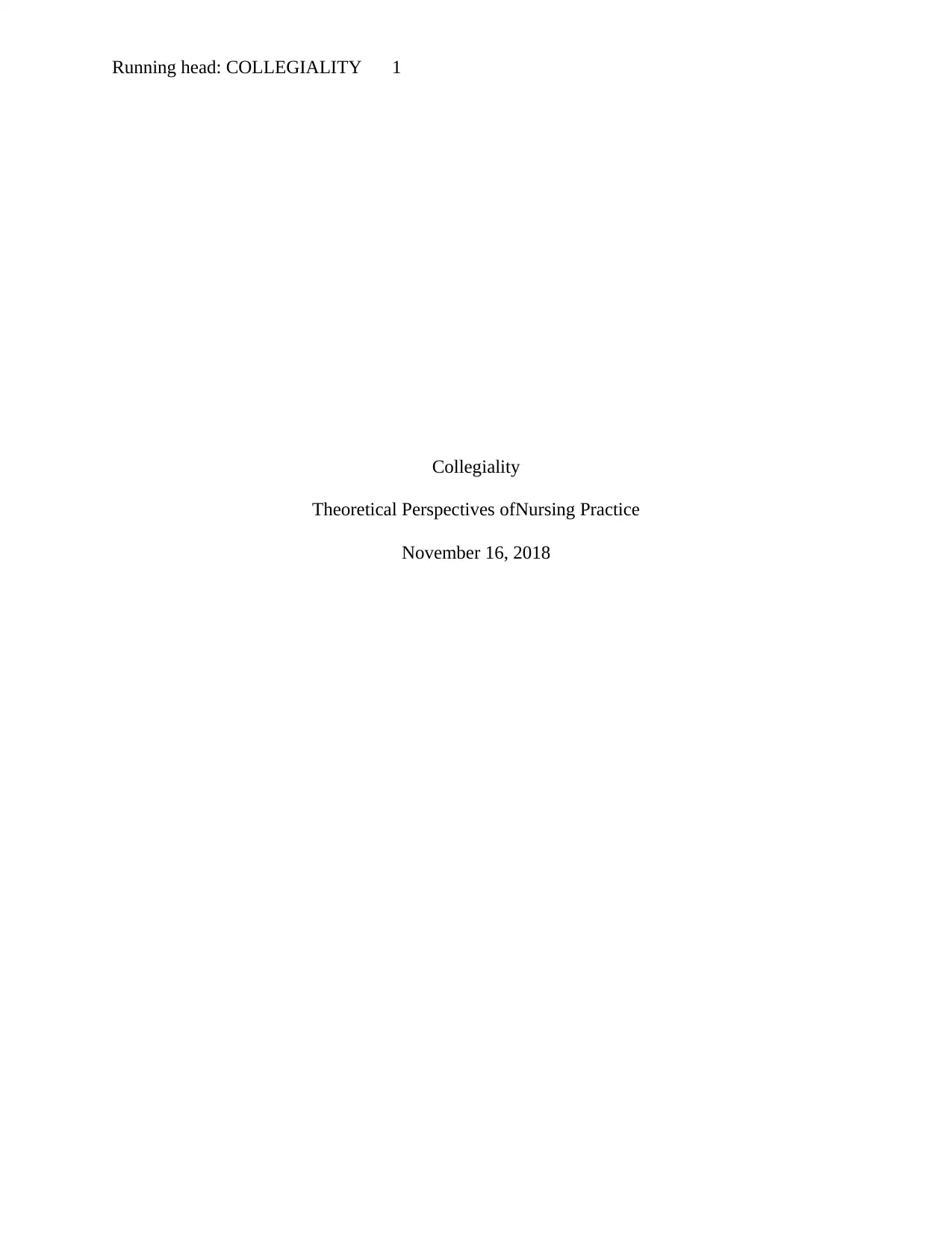
Running head: COLLEGIALITY 1
Collegiality
Theoretical Perspectives ofNursing Practice
November 16, 2018
Collegiality
Theoretical Perspectives ofNursing Practice
November 16, 2018
Secure Best Marks with AI Grader
Need help grading? Try our AI Grader for instant feedback on your assignments.
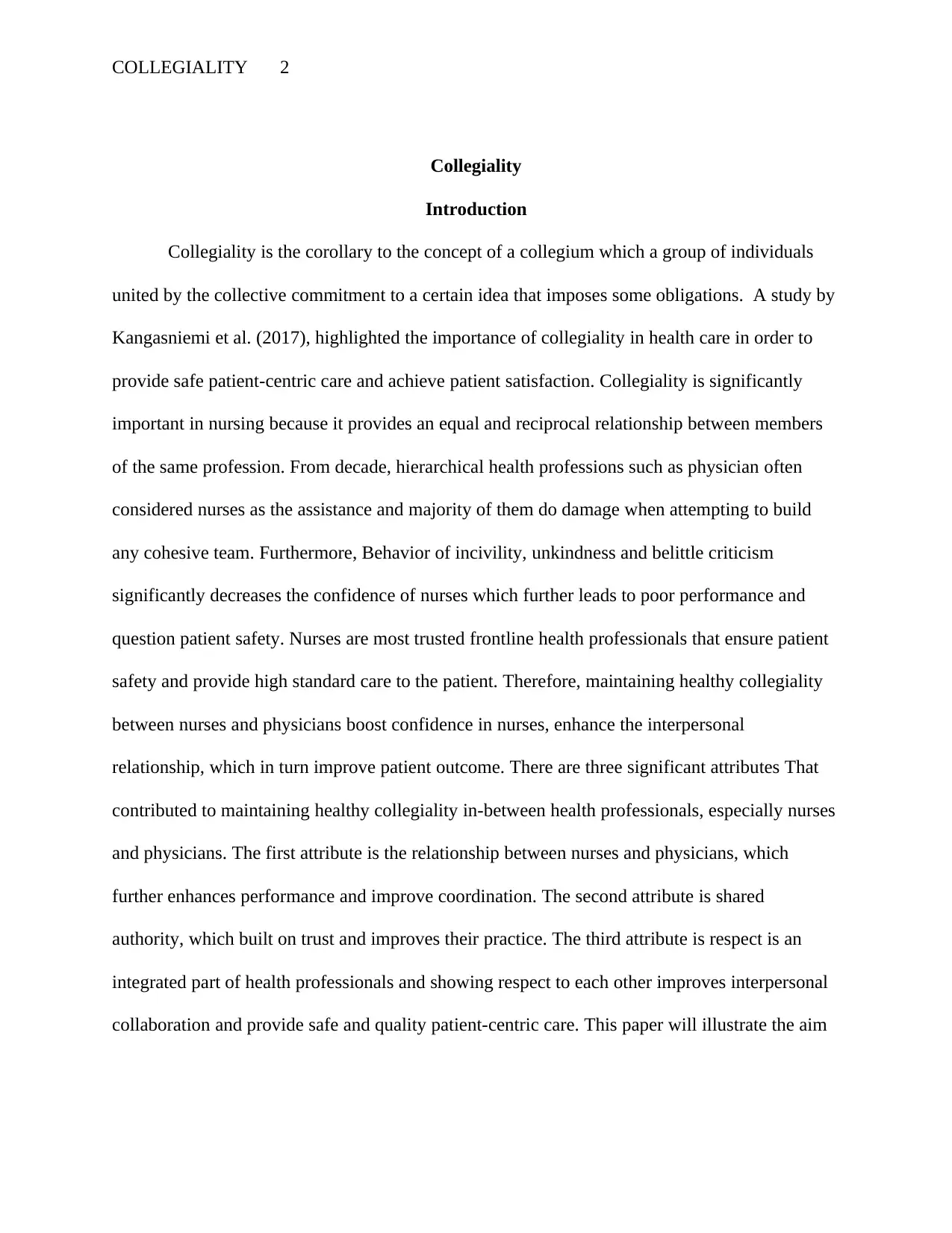
COLLEGIALITY 2
Collegiality
Introduction
Collegiality is the corollary to the concept of a collegium which a group of individuals
united by the collective commitment to a certain idea that imposes some obligations. A study by
Kangasniemi et al. (2017), highlighted the importance of collegiality in health care in order to
provide safe patient-centric care and achieve patient satisfaction. Collegiality is significantly
important in nursing because it provides an equal and reciprocal relationship between members
of the same profession. From decade, hierarchical health professions such as physician often
considered nurses as the assistance and majority of them do damage when attempting to build
any cohesive team. Furthermore, Behavior of incivility, unkindness and belittle criticism
significantly decreases the confidence of nurses which further leads to poor performance and
question patient safety. Nurses are most trusted frontline health professionals that ensure patient
safety and provide high standard care to the patient. Therefore, maintaining healthy collegiality
between nurses and physicians boost confidence in nurses, enhance the interpersonal
relationship, which in turn improve patient outcome. There are three significant attributes That
contributed to maintaining healthy collegiality in-between health professionals, especially nurses
and physicians. The first attribute is the relationship between nurses and physicians, which
further enhances performance and improve coordination. The second attribute is shared
authority, which built on trust and improves their practice. The third attribute is respect is an
integrated part of health professionals and showing respect to each other improves interpersonal
collaboration and provide safe and quality patient-centric care. This paper will illustrate the aim
Collegiality
Introduction
Collegiality is the corollary to the concept of a collegium which a group of individuals
united by the collective commitment to a certain idea that imposes some obligations. A study by
Kangasniemi et al. (2017), highlighted the importance of collegiality in health care in order to
provide safe patient-centric care and achieve patient satisfaction. Collegiality is significantly
important in nursing because it provides an equal and reciprocal relationship between members
of the same profession. From decade, hierarchical health professions such as physician often
considered nurses as the assistance and majority of them do damage when attempting to build
any cohesive team. Furthermore, Behavior of incivility, unkindness and belittle criticism
significantly decreases the confidence of nurses which further leads to poor performance and
question patient safety. Nurses are most trusted frontline health professionals that ensure patient
safety and provide high standard care to the patient. Therefore, maintaining healthy collegiality
between nurses and physicians boost confidence in nurses, enhance the interpersonal
relationship, which in turn improve patient outcome. There are three significant attributes That
contributed to maintaining healthy collegiality in-between health professionals, especially nurses
and physicians. The first attribute is the relationship between nurses and physicians, which
further enhances performance and improve coordination. The second attribute is shared
authority, which built on trust and improves their practice. The third attribute is respect is an
integrated part of health professionals and showing respect to each other improves interpersonal
collaboration and provide safe and quality patient-centric care. This paper will illustrate the aim
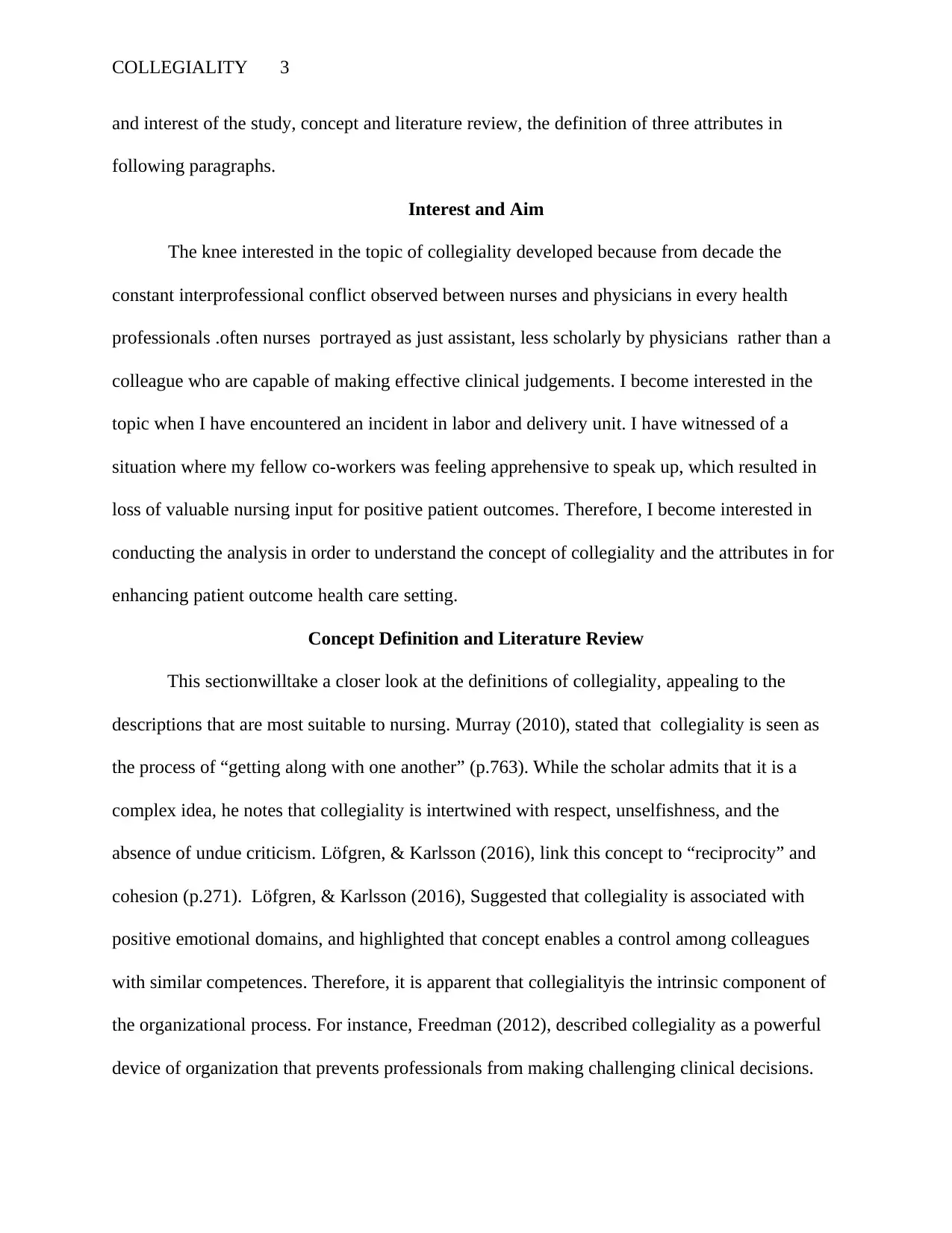
COLLEGIALITY 3
and interest of the study, concept and literature review, the definition of three attributes in
following paragraphs.
Interest and Aim
The knee interested in the topic of collegiality developed because from decade the
constant interprofessional conflict observed between nurses and physicians in every health
professionals .often nurses portrayed as just assistant, less scholarly by physicians rather than a
colleague who are capable of making effective clinical judgements. I become interested in the
topic when I have encountered an incident in labor and delivery unit. I have witnessed of a
situation where my fellow co-workers was feeling apprehensive to speak up, which resulted in
loss of valuable nursing input for positive patient outcomes. Therefore, I become interested in
conducting the analysis in order to understand the concept of collegiality and the attributes in for
enhancing patient outcome health care setting.
Concept Definition and Literature Review
This sectionwilltake a closer look at the definitions of collegiality, appealing to the
descriptions that are most suitable to nursing. Murray (2010), stated that collegiality is seen as
the process of “getting along with one another” (p.763). While the scholar admits that it is a
complex idea, he notes that collegiality is intertwined with respect, unselfishness, and the
absence of undue criticism. Löfgren, & Karlsson (2016), link this concept to “reciprocity” and
cohesion (p.271). Löfgren, & Karlsson (2016), Suggested that collegiality is associated with
positive emotional domains, and highlighted that concept enables a control among colleagues
with similar competences. Therefore, it is apparent that collegialityis the intrinsic component of
the organizational process. For instance, Freedman (2012), described collegiality as a powerful
device of organization that prevents professionals from making challenging clinical decisions.
and interest of the study, concept and literature review, the definition of three attributes in
following paragraphs.
Interest and Aim
The knee interested in the topic of collegiality developed because from decade the
constant interprofessional conflict observed between nurses and physicians in every health
professionals .often nurses portrayed as just assistant, less scholarly by physicians rather than a
colleague who are capable of making effective clinical judgements. I become interested in the
topic when I have encountered an incident in labor and delivery unit. I have witnessed of a
situation where my fellow co-workers was feeling apprehensive to speak up, which resulted in
loss of valuable nursing input for positive patient outcomes. Therefore, I become interested in
conducting the analysis in order to understand the concept of collegiality and the attributes in for
enhancing patient outcome health care setting.
Concept Definition and Literature Review
This sectionwilltake a closer look at the definitions of collegiality, appealing to the
descriptions that are most suitable to nursing. Murray (2010), stated that collegiality is seen as
the process of “getting along with one another” (p.763). While the scholar admits that it is a
complex idea, he notes that collegiality is intertwined with respect, unselfishness, and the
absence of undue criticism. Löfgren, & Karlsson (2016), link this concept to “reciprocity” and
cohesion (p.271). Löfgren, & Karlsson (2016), Suggested that collegiality is associated with
positive emotional domains, and highlighted that concept enables a control among colleagues
with similar competences. Therefore, it is apparent that collegialityis the intrinsic component of
the organizational process. For instance, Freedman (2012), described collegiality as a powerful
device of organization that prevents professionals from making challenging clinical decisions.

COLLEGIALITY 4
Yet, it is apparent that the common usage of collegiality is too general, while the
implementation of the concept in the field of nursing is much more specific. Padgett (2013),
suggested that collegiality is attributed to peer monitoring. In the clinical environment,
reviewing and monitoring of others’ work contribute to the eradication of the potential gaps and
errors in treatment that can lead to fatal consequences and adverse health outcomes. Another
study by Ditmer (2010), noted that the lack of collegiality contributed to the creation of
unsatisfying and “uncivil work environment” that hinders the professional development (p.10).
The rise of collegiality is associated with the eradication of violence and other manifestations of
the unprofessional behaviors in the nursing environment (Kangasniemi et al., 2017).
Burr, Collett, & Leung (2017), highlighted the value of collegiality and suggested that
the implementation of this concept prevents the concentration of power in one healthcare
professional. Thus, it becomes clear that collegiality helps avoid subjectivity and biasness of
treatment. Therefore, collegiality triggers the rise in the collective accountability and conscious
adherence to professional duties, and these factors are directly associated with the quality of
health outcomes of the patients. Stewart, Floyd, Thompson and Caldwell, (2015) stated that
collegiality boosts the sense of solidarity. Lowe and Tori( 2017) , further elaborated that true
meaning of this concept is “a true collaboration between health practitioners” rather than
working in “isolated silos” which in turn ensures that the focus of the treatment processes
remains on the patient. The researchers highlight the value of close proximity and mutual
respect since these features contribute to the substantial increase in proficiency and competence
among healthcare professionals.
Yet, it is apparent that the common usage of collegiality is too general, while the
implementation of the concept in the field of nursing is much more specific. Padgett (2013),
suggested that collegiality is attributed to peer monitoring. In the clinical environment,
reviewing and monitoring of others’ work contribute to the eradication of the potential gaps and
errors in treatment that can lead to fatal consequences and adverse health outcomes. Another
study by Ditmer (2010), noted that the lack of collegiality contributed to the creation of
unsatisfying and “uncivil work environment” that hinders the professional development (p.10).
The rise of collegiality is associated with the eradication of violence and other manifestations of
the unprofessional behaviors in the nursing environment (Kangasniemi et al., 2017).
Burr, Collett, & Leung (2017), highlighted the value of collegiality and suggested that
the implementation of this concept prevents the concentration of power in one healthcare
professional. Thus, it becomes clear that collegiality helps avoid subjectivity and biasness of
treatment. Therefore, collegiality triggers the rise in the collective accountability and conscious
adherence to professional duties, and these factors are directly associated with the quality of
health outcomes of the patients. Stewart, Floyd, Thompson and Caldwell, (2015) stated that
collegiality boosts the sense of solidarity. Lowe and Tori( 2017) , further elaborated that true
meaning of this concept is “a true collaboration between health practitioners” rather than
working in “isolated silos” which in turn ensures that the focus of the treatment processes
remains on the patient. The researchers highlight the value of close proximity and mutual
respect since these features contribute to the substantial increase in proficiency and competence
among healthcare professionals.
Secure Best Marks with AI Grader
Need help grading? Try our AI Grader for instant feedback on your assignments.
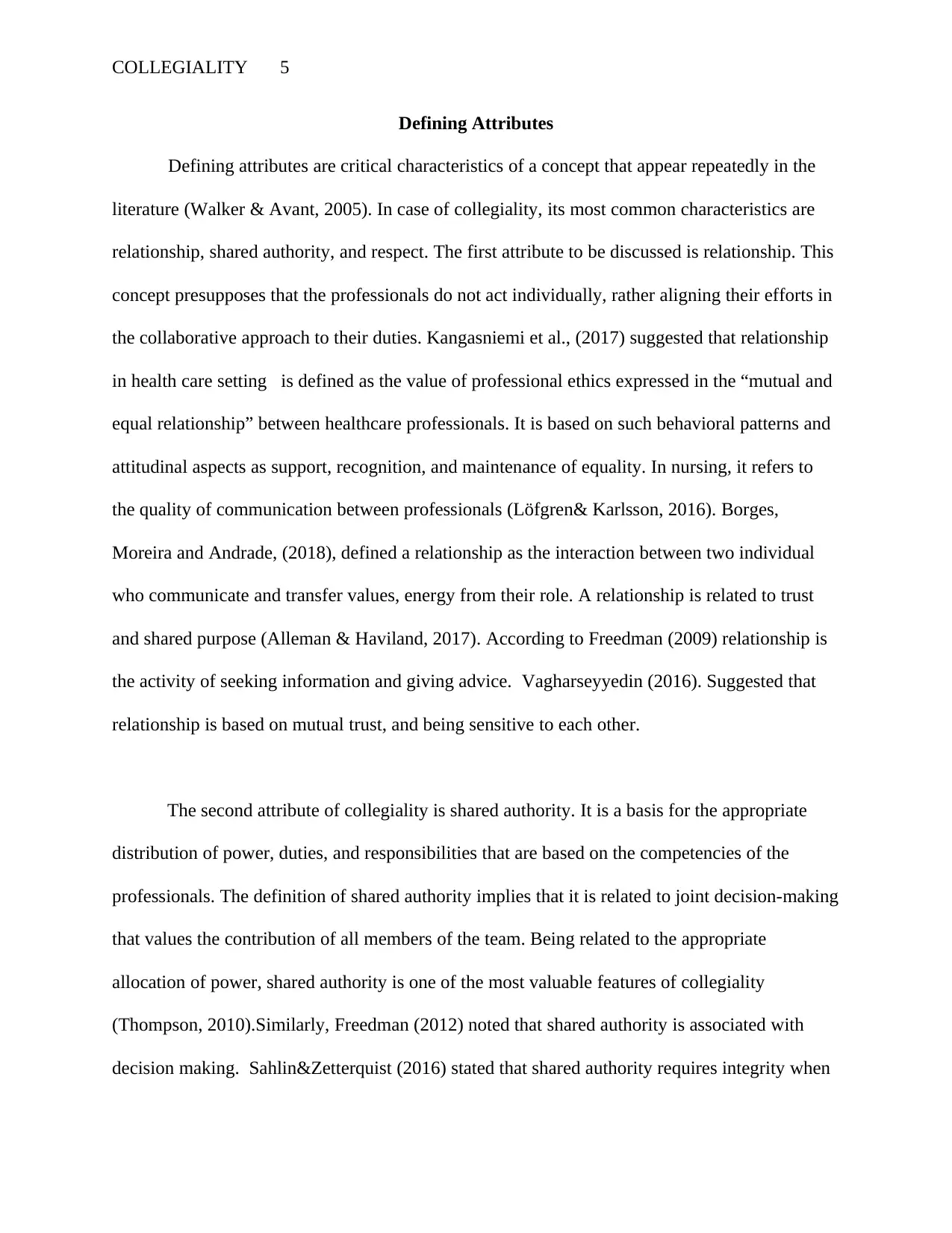
COLLEGIALITY 5
Defining Attributes
Defining attributes are critical characteristics of a concept that appear repeatedly in the
literature (Walker & Avant, 2005). In case of collegiality, its most common characteristics are
relationship, shared authority, and respect. The first attribute to be discussed is relationship. This
concept presupposes that the professionals do not act individually, rather aligning their efforts in
the collaborative approach to their duties. Kangasniemi et al., (2017) suggested that relationship
in health care setting is defined as the value of professional ethics expressed in the “mutual and
equal relationship” between healthcare professionals. It is based on such behavioral patterns and
attitudinal aspects as support, recognition, and maintenance of equality. In nursing, it refers to
the quality of communication between professionals (Löfgren& Karlsson, 2016). Borges,
Moreira and Andrade, (2018), defined a relationship as the interaction between two individual
who communicate and transfer values, energy from their role. A relationship is related to trust
and shared purpose (Alleman & Haviland, 2017). According to Freedman (2009) relationship is
the activity of seeking information and giving advice. Vagharseyyedin (2016). Suggested that
relationship is based on mutual trust, and being sensitive to each other.
The second attribute of collegiality is shared authority. It is a basis for the appropriate
distribution of power, duties, and responsibilities that are based on the competencies of the
professionals. The definition of shared authority implies that it is related to joint decision-making
that values the contribution of all members of the team. Being related to the appropriate
allocation of power, shared authority is one of the most valuable features of collegiality
(Thompson, 2010).Similarly, Freedman (2012) noted that shared authority is associated with
decision making. Sahlin&Zetterquist (2016) stated that shared authority requires integrity when
Defining Attributes
Defining attributes are critical characteristics of a concept that appear repeatedly in the
literature (Walker & Avant, 2005). In case of collegiality, its most common characteristics are
relationship, shared authority, and respect. The first attribute to be discussed is relationship. This
concept presupposes that the professionals do not act individually, rather aligning their efforts in
the collaborative approach to their duties. Kangasniemi et al., (2017) suggested that relationship
in health care setting is defined as the value of professional ethics expressed in the “mutual and
equal relationship” between healthcare professionals. It is based on such behavioral patterns and
attitudinal aspects as support, recognition, and maintenance of equality. In nursing, it refers to
the quality of communication between professionals (Löfgren& Karlsson, 2016). Borges,
Moreira and Andrade, (2018), defined a relationship as the interaction between two individual
who communicate and transfer values, energy from their role. A relationship is related to trust
and shared purpose (Alleman & Haviland, 2017). According to Freedman (2009) relationship is
the activity of seeking information and giving advice. Vagharseyyedin (2016). Suggested that
relationship is based on mutual trust, and being sensitive to each other.
The second attribute of collegiality is shared authority. It is a basis for the appropriate
distribution of power, duties, and responsibilities that are based on the competencies of the
professionals. The definition of shared authority implies that it is related to joint decision-making
that values the contribution of all members of the team. Being related to the appropriate
allocation of power, shared authority is one of the most valuable features of collegiality
(Thompson, 2010).Similarly, Freedman (2012) noted that shared authority is associated with
decision making. Sahlin&Zetterquist (2016) stated that shared authority requires integrity when
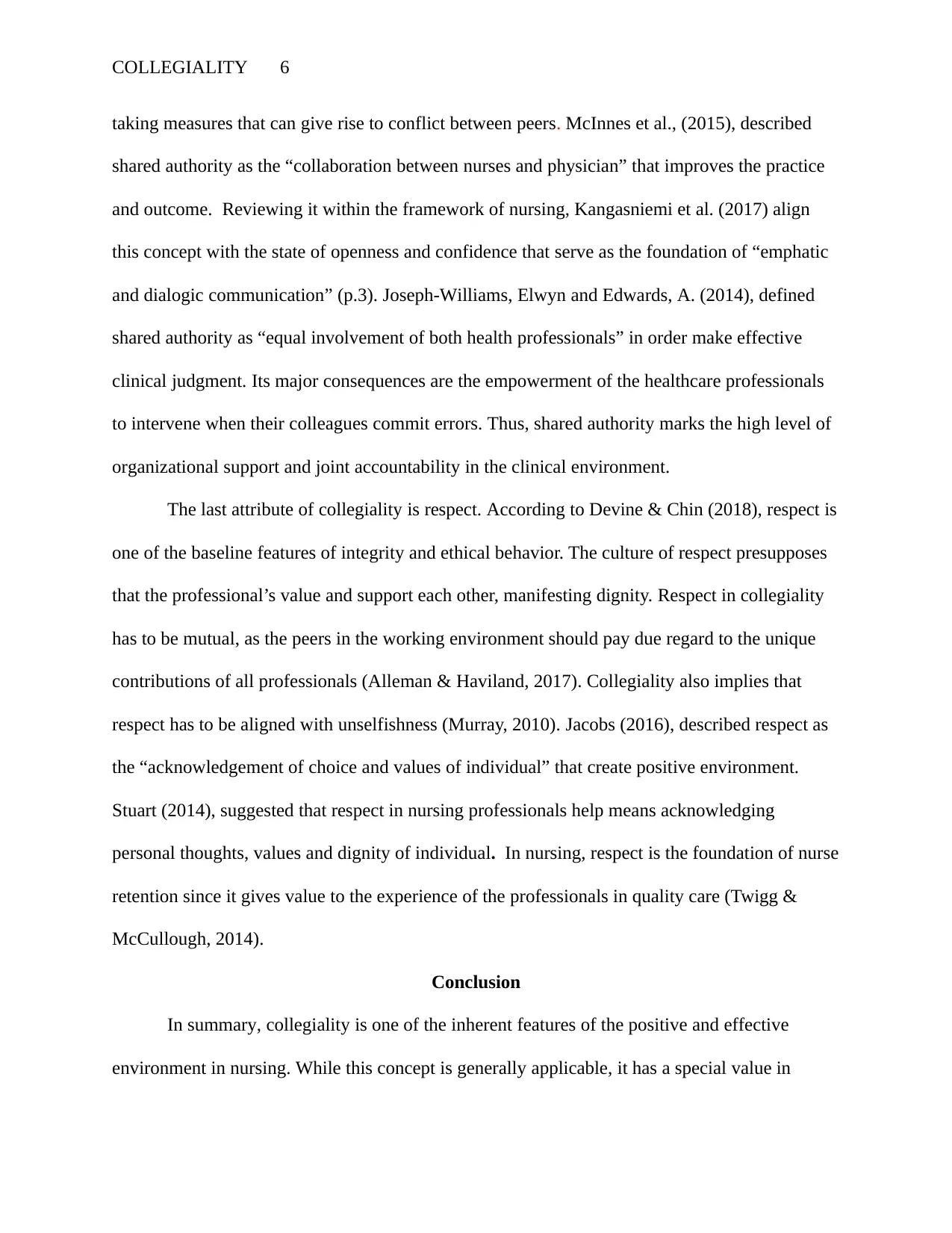
COLLEGIALITY 6
taking measures that can give rise to conflict between peers. McInnes et al., (2015), described
shared authority as the “collaboration between nurses and physician” that improves the practice
and outcome. Reviewing it within the framework of nursing, Kangasniemi et al. (2017) align
this concept with the state of openness and confidence that serve as the foundation of “emphatic
and dialogic communication” (p.3). Joseph-Williams, Elwyn and Edwards, A. (2014), defined
shared authority as “equal involvement of both health professionals” in order make effective
clinical judgment. Its major consequences are the empowerment of the healthcare professionals
to intervene when their colleagues commit errors. Thus, shared authority marks the high level of
organizational support and joint accountability in the clinical environment.
The last attribute of collegiality is respect. According to Devine & Chin (2018), respect is
one of the baseline features of integrity and ethical behavior. The culture of respect presupposes
that the professional’s value and support each other, manifesting dignity. Respect in collegiality
has to be mutual, as the peers in the working environment should pay due regard to the unique
contributions of all professionals (Alleman & Haviland, 2017). Collegiality also implies that
respect has to be aligned with unselfishness (Murray, 2010). Jacobs (2016), described respect as
the “acknowledgement of choice and values of individual” that create positive environment.
Stuart (2014), suggested that respect in nursing professionals help means acknowledging
personal thoughts, values and dignity of individual. In nursing, respect is the foundation of nurse
retention since it gives value to the experience of the professionals in quality care (Twigg &
McCullough, 2014).
Conclusion
In summary, collegiality is one of the inherent features of the positive and effective
environment in nursing. While this concept is generally applicable, it has a special value in
taking measures that can give rise to conflict between peers. McInnes et al., (2015), described
shared authority as the “collaboration between nurses and physician” that improves the practice
and outcome. Reviewing it within the framework of nursing, Kangasniemi et al. (2017) align
this concept with the state of openness and confidence that serve as the foundation of “emphatic
and dialogic communication” (p.3). Joseph-Williams, Elwyn and Edwards, A. (2014), defined
shared authority as “equal involvement of both health professionals” in order make effective
clinical judgment. Its major consequences are the empowerment of the healthcare professionals
to intervene when their colleagues commit errors. Thus, shared authority marks the high level of
organizational support and joint accountability in the clinical environment.
The last attribute of collegiality is respect. According to Devine & Chin (2018), respect is
one of the baseline features of integrity and ethical behavior. The culture of respect presupposes
that the professional’s value and support each other, manifesting dignity. Respect in collegiality
has to be mutual, as the peers in the working environment should pay due regard to the unique
contributions of all professionals (Alleman & Haviland, 2017). Collegiality also implies that
respect has to be aligned with unselfishness (Murray, 2010). Jacobs (2016), described respect as
the “acknowledgement of choice and values of individual” that create positive environment.
Stuart (2014), suggested that respect in nursing professionals help means acknowledging
personal thoughts, values and dignity of individual. In nursing, respect is the foundation of nurse
retention since it gives value to the experience of the professionals in quality care (Twigg &
McCullough, 2014).
Conclusion
In summary, collegiality is one of the inherent features of the positive and effective
environment in nursing. While this concept is generally applicable, it has a special value in
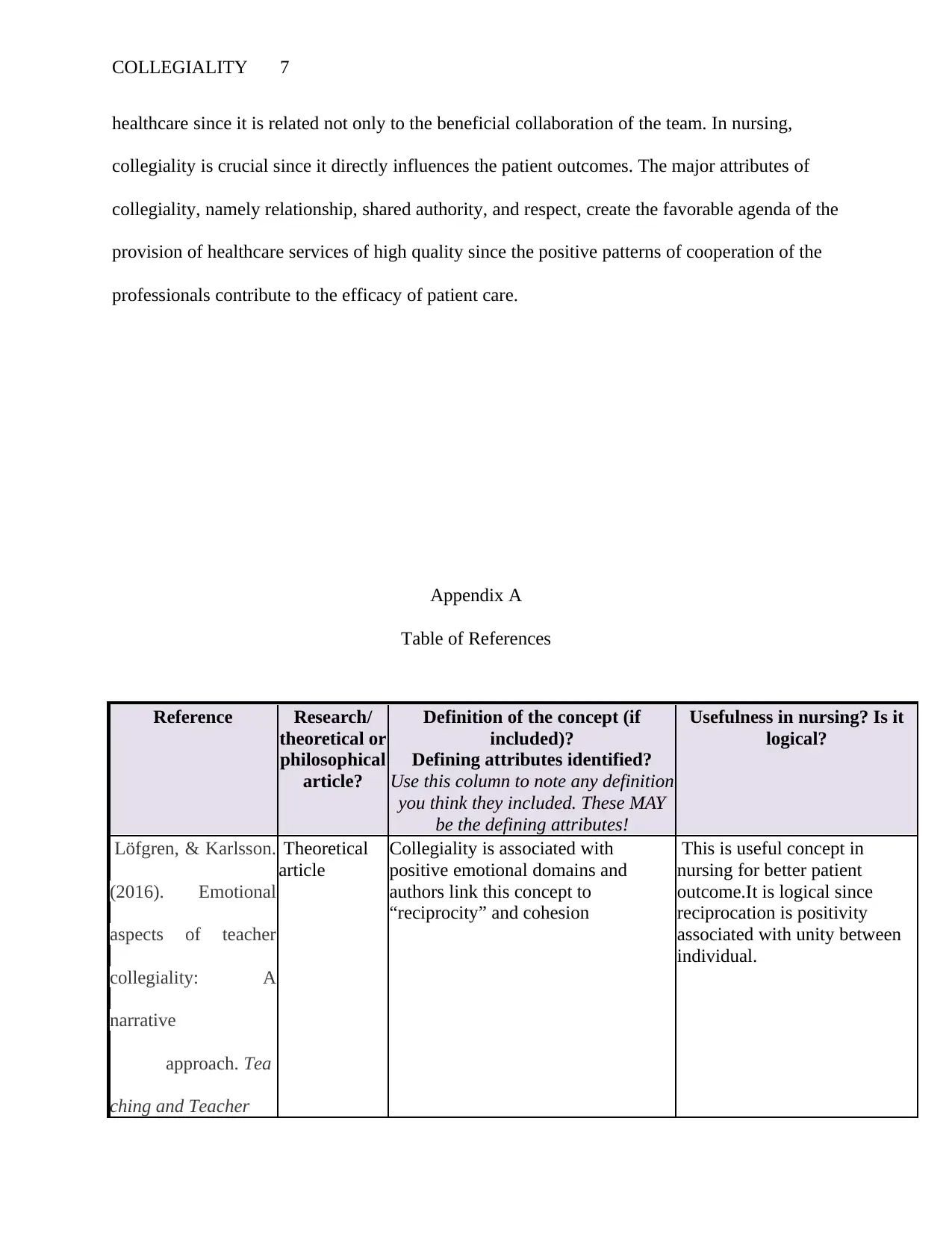
COLLEGIALITY 7
healthcare since it is related not only to the beneficial collaboration of the team. In nursing,
collegiality is crucial since it directly influences the patient outcomes. The major attributes of
collegiality, namely relationship, shared authority, and respect, create the favorable agenda of the
provision of healthcare services of high quality since the positive patterns of cooperation of the
professionals contribute to the efficacy of patient care.
Appendix A
Table of References
Reference Research/
theoretical or
philosophical
article?
Definition of the concept (if
included)?
Defining attributes identified?
Use this column to note any definition
you think they included. These MAY
be the defining attributes!
Usefulness in nursing? Is it
logical?
Löfgren, & Karlsson.
(2016). Emotional
aspects of teacher
collegiality: A
narrative
approach. Tea
ching and Teacher
Theoretical
article
Collegiality is associated with
positive emotional domains and
authors link this concept to
“reciprocity” and cohesion
This is useful concept in
nursing for better patient
outcome.It is logical since
reciprocation is positivity
associated with unity between
individual.
healthcare since it is related not only to the beneficial collaboration of the team. In nursing,
collegiality is crucial since it directly influences the patient outcomes. The major attributes of
collegiality, namely relationship, shared authority, and respect, create the favorable agenda of the
provision of healthcare services of high quality since the positive patterns of cooperation of the
professionals contribute to the efficacy of patient care.
Appendix A
Table of References
Reference Research/
theoretical or
philosophical
article?
Definition of the concept (if
included)?
Defining attributes identified?
Use this column to note any definition
you think they included. These MAY
be the defining attributes!
Usefulness in nursing? Is it
logical?
Löfgren, & Karlsson.
(2016). Emotional
aspects of teacher
collegiality: A
narrative
approach. Tea
ching and Teacher
Theoretical
article
Collegiality is associated with
positive emotional domains and
authors link this concept to
“reciprocity” and cohesion
This is useful concept in
nursing for better patient
outcome.It is logical since
reciprocation is positivity
associated with unity between
individual.
Paraphrase This Document
Need a fresh take? Get an instant paraphrase of this document with our AI Paraphraser
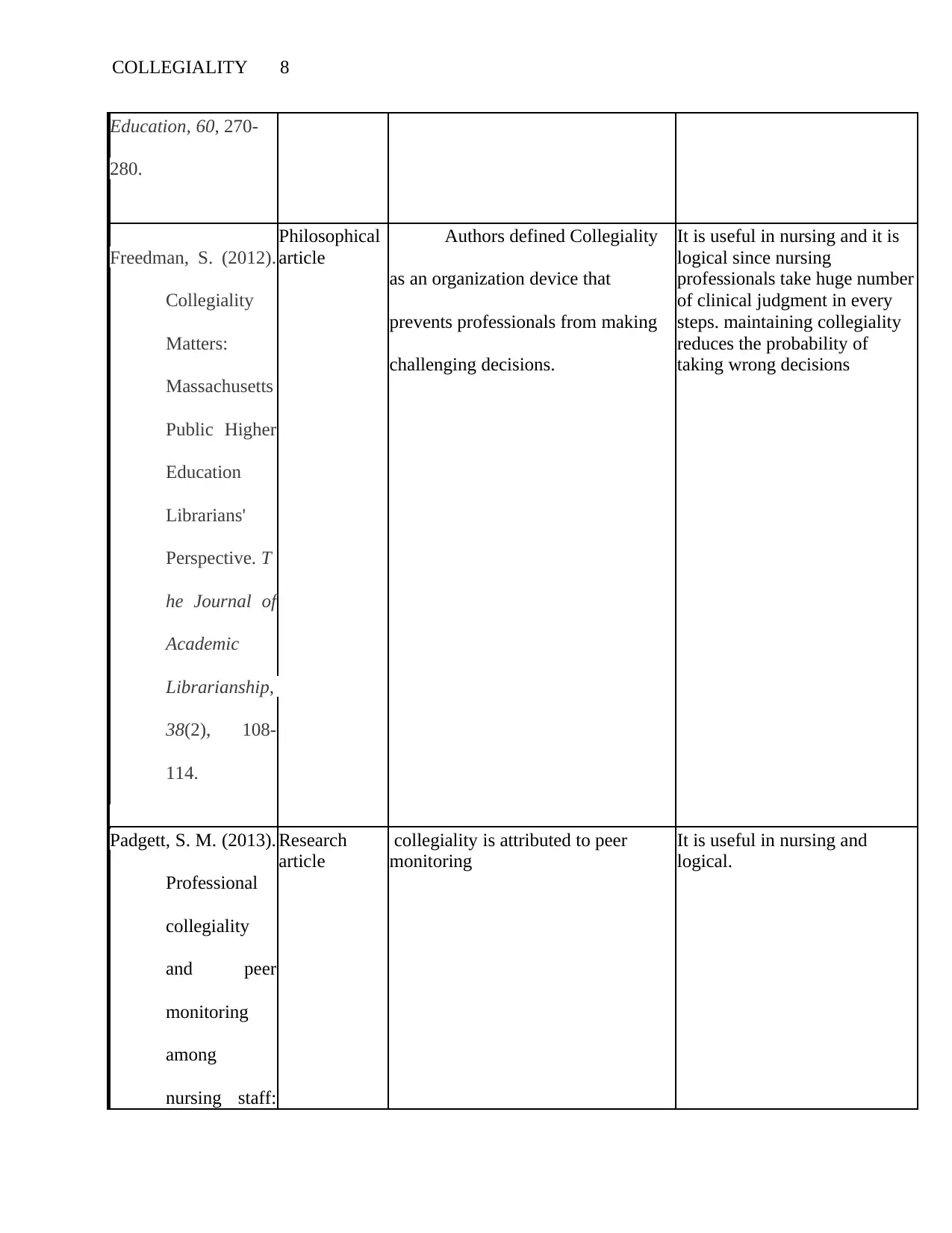
COLLEGIALITY 8
Education, 60, 270-
280.
Freedman, S. (2012).
Collegiality
Matters:
Massachusetts
Public Higher
Education
Librarians'
Perspective. T
he Journal of
Academic
Librarianship,
38(2), 108-
114.
Philosophical
article
Authors defined Collegiality
as an organization device that
prevents professionals from making
challenging decisions.
It is useful in nursing and it is
logical since nursing
professionals take huge number
of clinical judgment in every
steps. maintaining collegiality
reduces the probability of
taking wrong decisions
Padgett, S. M. (2013).
Professional
collegiality
and peer
monitoring
among
nursing staff:
Research
article
collegiality is attributed to peer
monitoring
It is useful in nursing and
logical.
Education, 60, 270-
280.
Freedman, S. (2012).
Collegiality
Matters:
Massachusetts
Public Higher
Education
Librarians'
Perspective. T
he Journal of
Academic
Librarianship,
38(2), 108-
114.
Philosophical
article
Authors defined Collegiality
as an organization device that
prevents professionals from making
challenging decisions.
It is useful in nursing and it is
logical since nursing
professionals take huge number
of clinical judgment in every
steps. maintaining collegiality
reduces the probability of
taking wrong decisions
Padgett, S. M. (2013).
Professional
collegiality
and peer
monitoring
among
nursing staff:
Research
article
collegiality is attributed to peer
monitoring
It is useful in nursing and
logical.
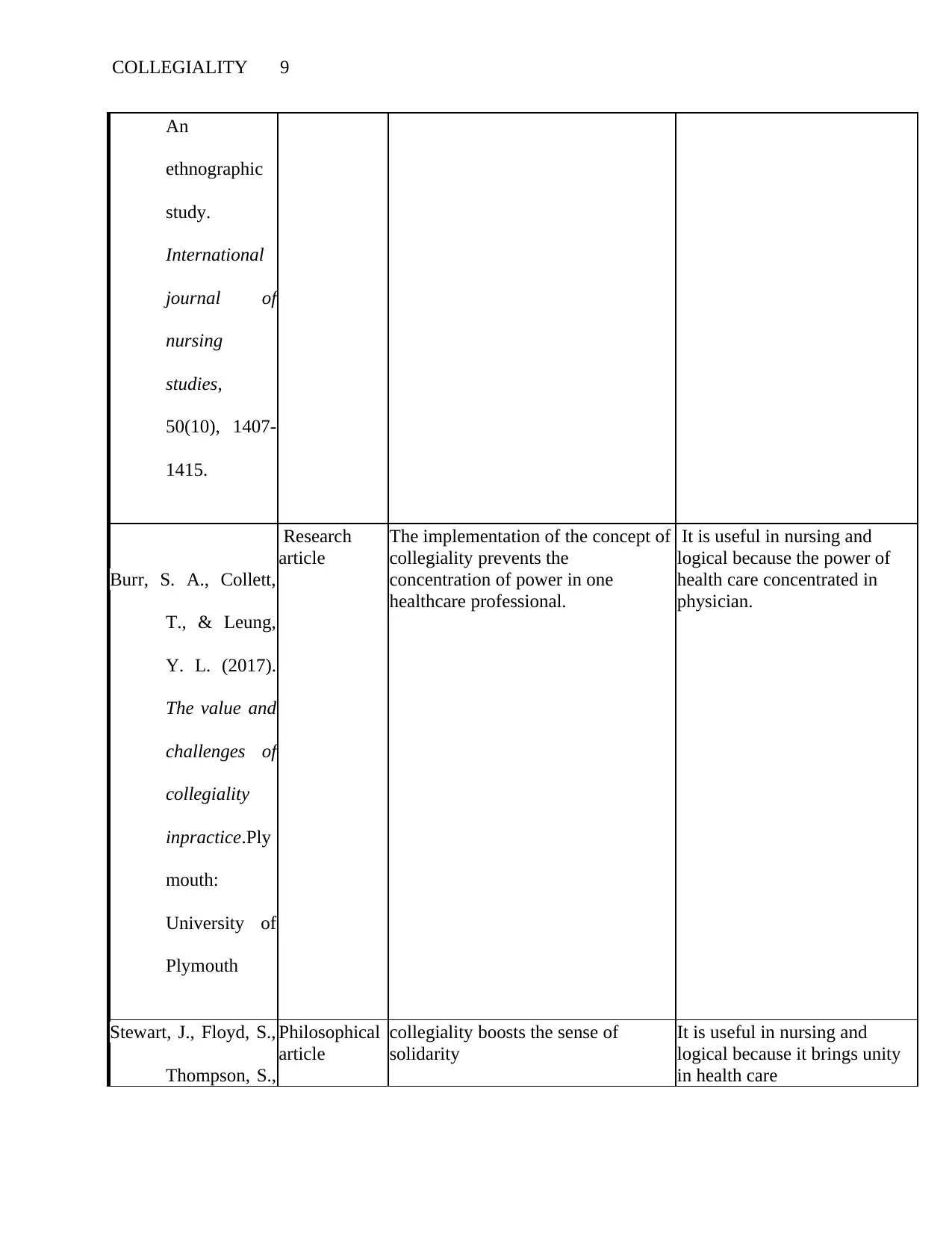
COLLEGIALITY 9
An
ethnographic
study.
International
journal of
nursing
studies,
50(10), 1407-
1415.
Burr, S. A., Collett,
T., & Leung,
Y. L. (2017).
The value and
challenges of
collegiality
inpractice.Ply
mouth:
University of
Plymouth
Research
article
The implementation of the concept of
collegiality prevents the
concentration of power in one
healthcare professional.
It is useful in nursing and
logical because the power of
health care concentrated in
physician.
Stewart, J., Floyd, S.,
Thompson, S.,
Philosophical
article
collegiality boosts the sense of
solidarity
It is useful in nursing and
logical because it brings unity
in health care
An
ethnographic
study.
International
journal of
nursing
studies,
50(10), 1407-
1415.
Burr, S. A., Collett,
T., & Leung,
Y. L. (2017).
The value and
challenges of
collegiality
inpractice.Ply
mouth:
University of
Plymouth
Research
article
The implementation of the concept of
collegiality prevents the
concentration of power in one
healthcare professional.
It is useful in nursing and
logical because the power of
health care concentrated in
physician.
Stewart, J., Floyd, S.,
Thompson, S.,
Philosophical
article
collegiality boosts the sense of
solidarity
It is useful in nursing and
logical because it brings unity
in health care
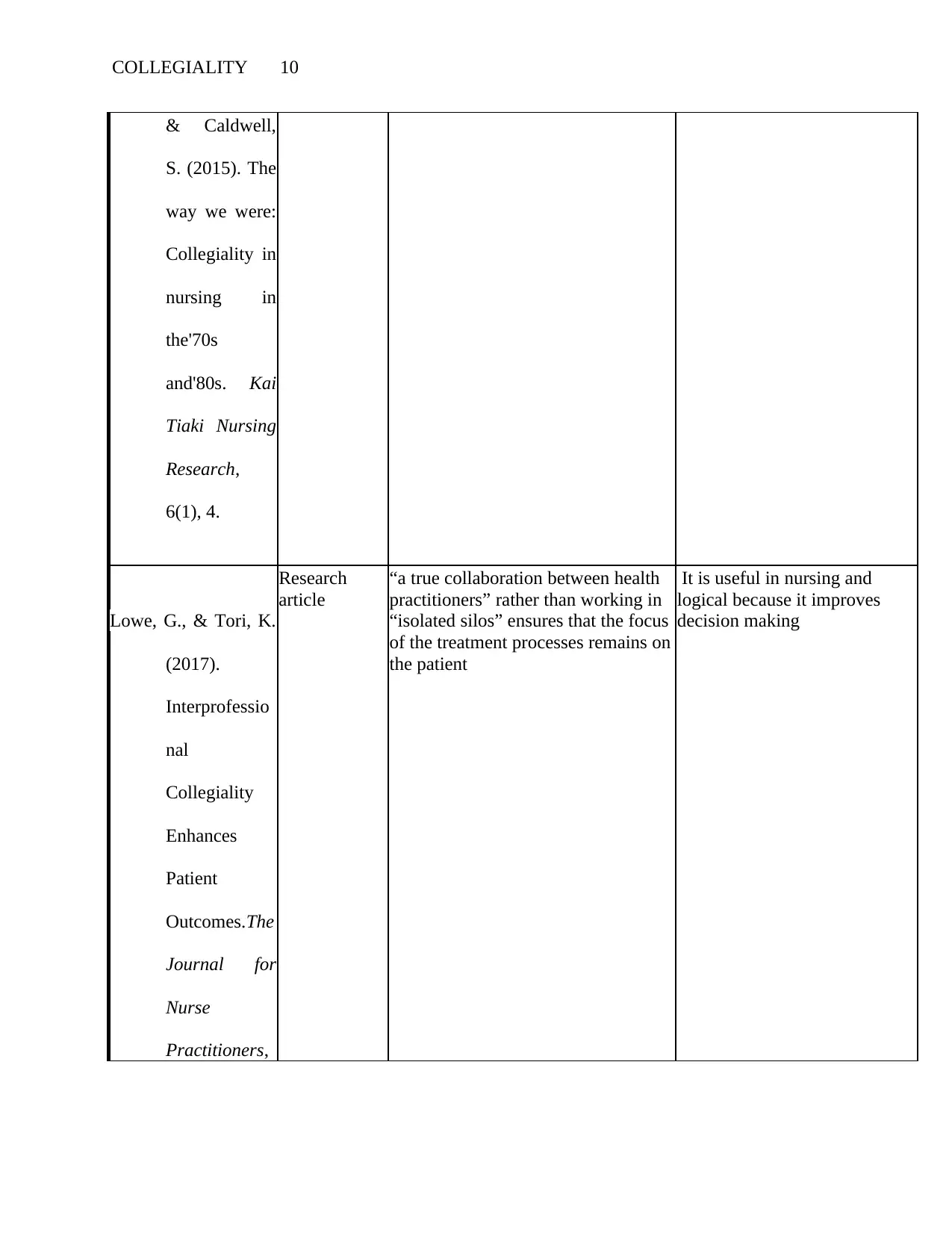
COLLEGIALITY 10
& Caldwell,
S. (2015). The
way we were:
Collegiality in
nursing in
the'70s
and'80s. Kai
Tiaki Nursing
Research,
6(1), 4.
Lowe, G., & Tori, K.
(2017).
Interprofessio
nal
Collegiality
Enhances
Patient
Outcomes.The
Journal for
Nurse
Practitioners,
Research
article
“a true collaboration between health
practitioners” rather than working in
“isolated silos” ensures that the focus
of the treatment processes remains on
the patient
It is useful in nursing and
logical because it improves
decision making
& Caldwell,
S. (2015). The
way we were:
Collegiality in
nursing in
the'70s
and'80s. Kai
Tiaki Nursing
Research,
6(1), 4.
Lowe, G., & Tori, K.
(2017).
Interprofessio
nal
Collegiality
Enhances
Patient
Outcomes.The
Journal for
Nurse
Practitioners,
Research
article
“a true collaboration between health
practitioners” rather than working in
“isolated silos” ensures that the focus
of the treatment processes remains on
the patient
It is useful in nursing and
logical because it improves
decision making
Secure Best Marks with AI Grader
Need help grading? Try our AI Grader for instant feedback on your assignments.
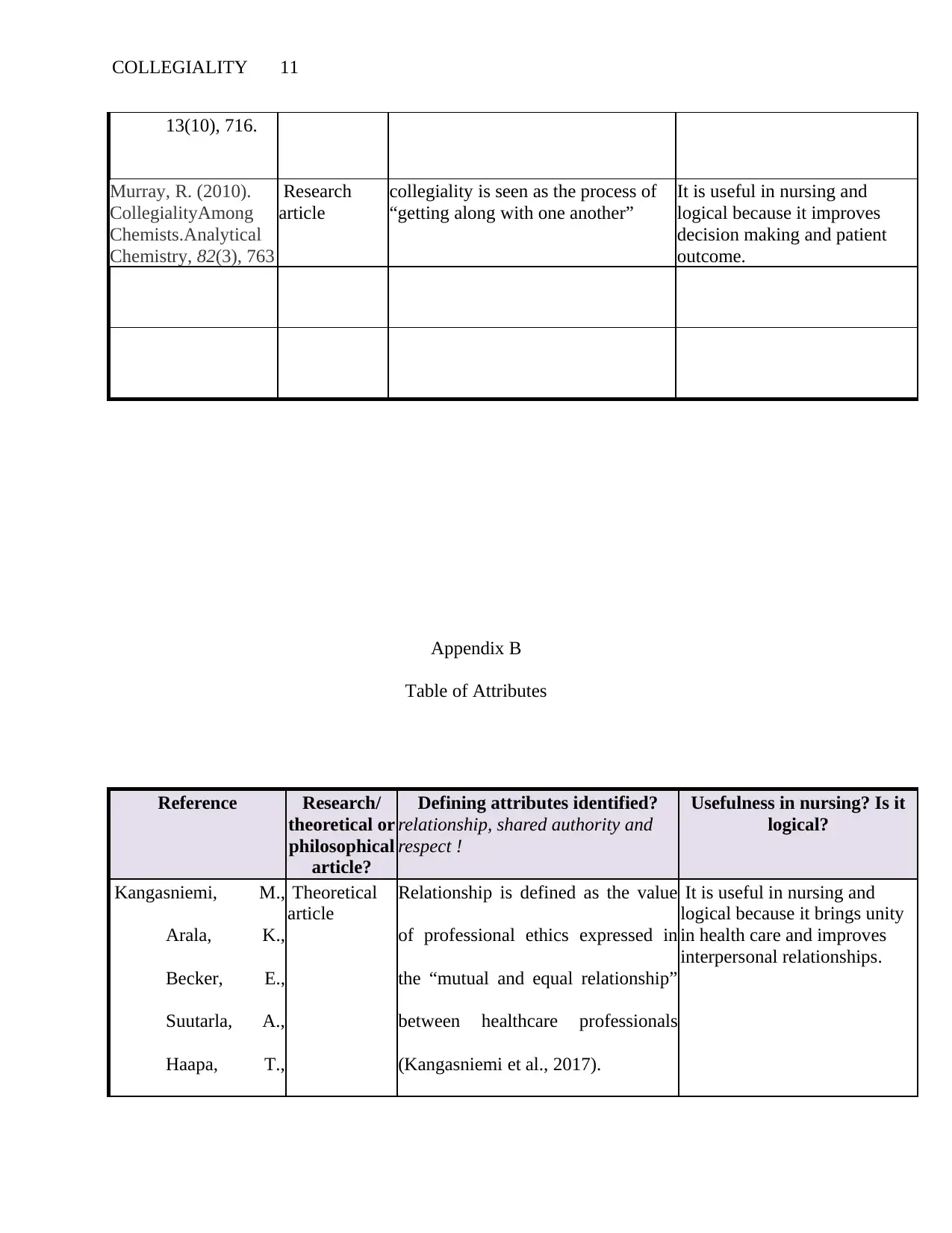
COLLEGIALITY 11
13(10), 716.
Murray, R. (2010).
CollegialityAmong
Chemists.Analytical
Chemistry, 82(3), 763
Research
article
collegiality is seen as the process of
“getting along with one another”
It is useful in nursing and
logical because it improves
decision making and patient
outcome.
Appendix B
Table of Attributes
Reference Research/
theoretical or
philosophical
article?
Defining attributes identified?
relationship, shared authority and
respect !
Usefulness in nursing? Is it
logical?
Kangasniemi, M.,
Arala, K.,
Becker, E.,
Suutarla, A.,
Haapa, T.,
Theoretical
article
Relationship is defined as the value
of professional ethics expressed in
the “mutual and equal relationship”
between healthcare professionals
(Kangasniemi et al., 2017).
It is useful in nursing and
logical because it brings unity
in health care and improves
interpersonal relationships.
13(10), 716.
Murray, R. (2010).
CollegialityAmong
Chemists.Analytical
Chemistry, 82(3), 763
Research
article
collegiality is seen as the process of
“getting along with one another”
It is useful in nursing and
logical because it improves
decision making and patient
outcome.
Appendix B
Table of Attributes
Reference Research/
theoretical or
philosophical
article?
Defining attributes identified?
relationship, shared authority and
respect !
Usefulness in nursing? Is it
logical?
Kangasniemi, M.,
Arala, K.,
Becker, E.,
Suutarla, A.,
Haapa, T.,
Theoretical
article
Relationship is defined as the value
of professional ethics expressed in
the “mutual and equal relationship”
between healthcare professionals
(Kangasniemi et al., 2017).
It is useful in nursing and
logical because it brings unity
in health care and improves
interpersonal relationships.
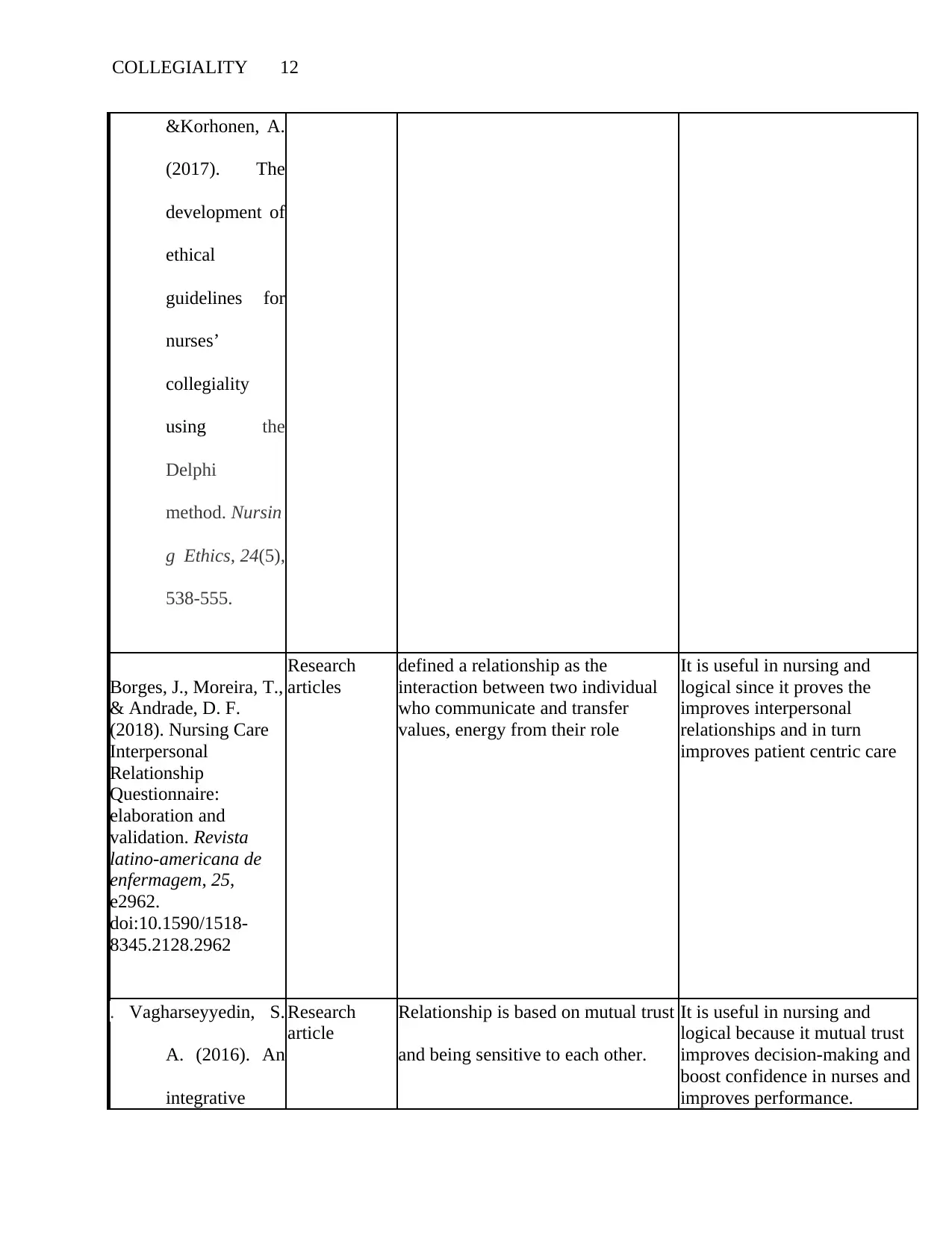
COLLEGIALITY 12
&Korhonen, A.
(2017). The
development of
ethical
guidelines for
nurses’
collegiality
using the
Delphi
method. Nursin
g Ethics, 24(5),
538-555.
Borges, J., Moreira, T.,
& Andrade, D. F.
(2018). Nursing Care
Interpersonal
Relationship
Questionnaire:
elaboration and
validation. Revista
latino-americana de
enfermagem, 25,
e2962.
doi:10.1590/1518-
8345.2128.2962
Research
articles
defined a relationship as the
interaction between two individual
who communicate and transfer
values, energy from their role
It is useful in nursing and
logical since it proves the
improves interpersonal
relationships and in turn
improves patient centric care
. Vagharseyyedin, S.
A. (2016). An
integrative
Research
article
Relationship is based on mutual trust
and being sensitive to each other.
It is useful in nursing and
logical because it mutual trust
improves decision-making and
boost confidence in nurses and
improves performance.
&Korhonen, A.
(2017). The
development of
ethical
guidelines for
nurses’
collegiality
using the
Delphi
method. Nursin
g Ethics, 24(5),
538-555.
Borges, J., Moreira, T.,
& Andrade, D. F.
(2018). Nursing Care
Interpersonal
Relationship
Questionnaire:
elaboration and
validation. Revista
latino-americana de
enfermagem, 25,
e2962.
doi:10.1590/1518-
8345.2128.2962
Research
articles
defined a relationship as the
interaction between two individual
who communicate and transfer
values, energy from their role
It is useful in nursing and
logical since it proves the
improves interpersonal
relationships and in turn
improves patient centric care
. Vagharseyyedin, S.
A. (2016). An
integrative
Research
article
Relationship is based on mutual trust
and being sensitive to each other.
It is useful in nursing and
logical because it mutual trust
improves decision-making and
boost confidence in nurses and
improves performance.
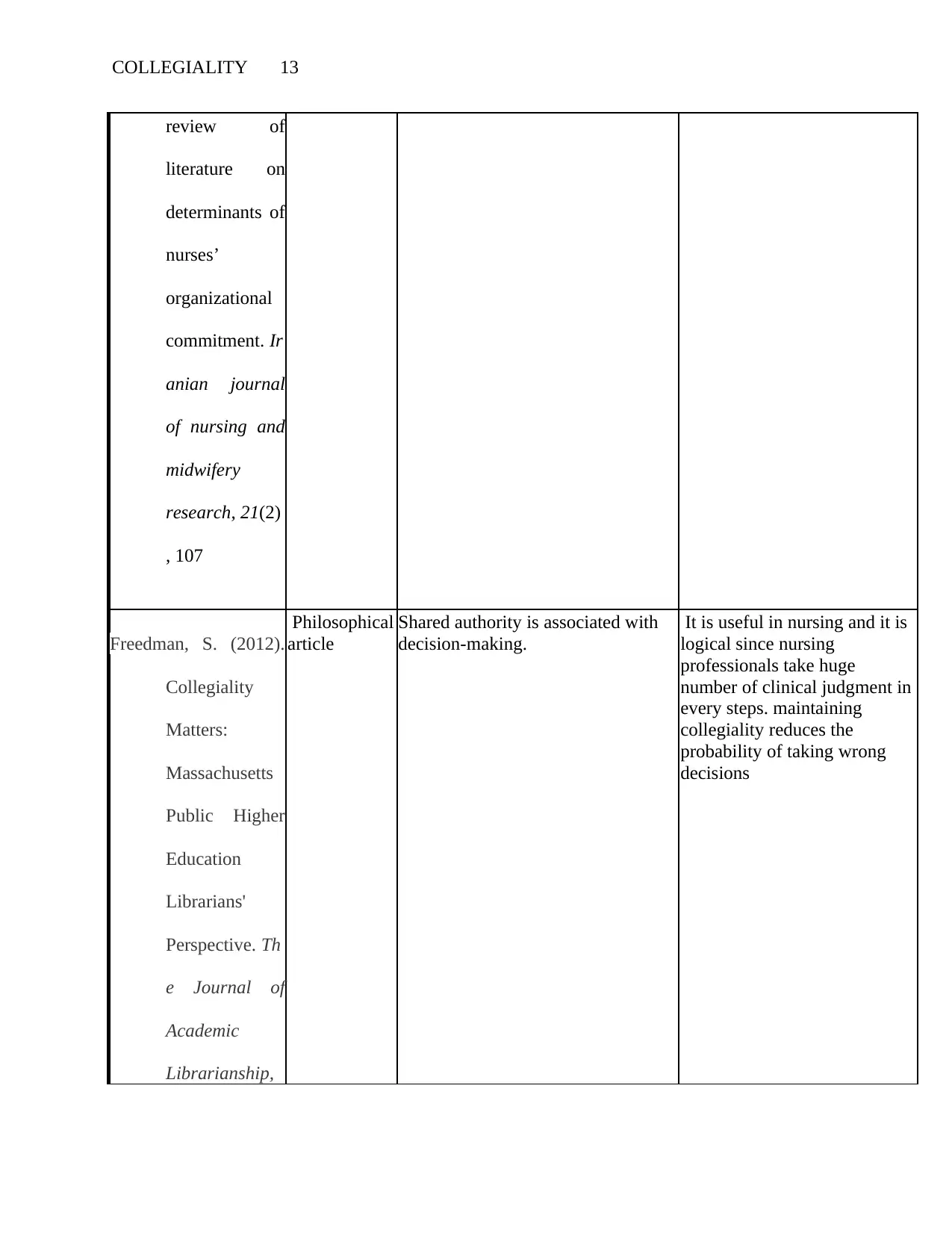
COLLEGIALITY 13
review of
literature on
determinants of
nurses’
organizational
commitment. Ir
anian journal
of nursing and
midwifery
research, 21(2)
, 107
Freedman, S. (2012).
Collegiality
Matters:
Massachusetts
Public Higher
Education
Librarians'
Perspective. Th
e Journal of
Academic
Librarianship,
Philosophical
article
Shared authority is associated with
decision-making.
It is useful in nursing and it is
logical since nursing
professionals take huge
number of clinical judgment in
every steps. maintaining
collegiality reduces the
probability of taking wrong
decisions
review of
literature on
determinants of
nurses’
organizational
commitment. Ir
anian journal
of nursing and
midwifery
research, 21(2)
, 107
Freedman, S. (2012).
Collegiality
Matters:
Massachusetts
Public Higher
Education
Librarians'
Perspective. Th
e Journal of
Academic
Librarianship,
Philosophical
article
Shared authority is associated with
decision-making.
It is useful in nursing and it is
logical since nursing
professionals take huge
number of clinical judgment in
every steps. maintaining
collegiality reduces the
probability of taking wrong
decisions
Paraphrase This Document
Need a fresh take? Get an instant paraphrase of this document with our AI Paraphraser
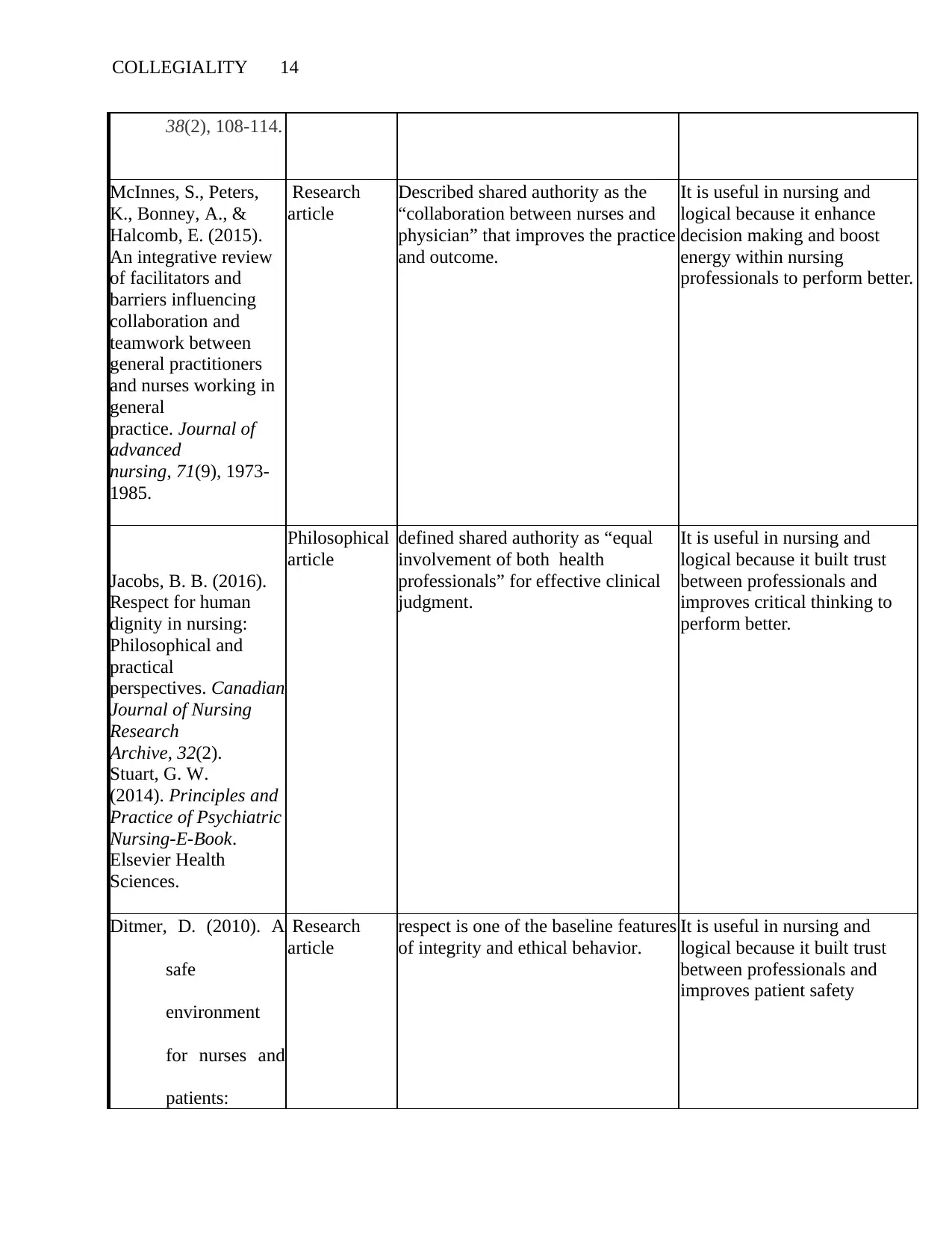
COLLEGIALITY 14
38(2), 108-114.
McInnes, S., Peters,
K., Bonney, A., &
Halcomb, E. (2015).
An integrative review
of facilitators and
barriers influencing
collaboration and
teamwork between
general practitioners
and nurses working in
general
practice. Journal of
advanced
nursing, 71(9), 1973-
1985.
Research
article
Described shared authority as the
“collaboration between nurses and
physician” that improves the practice
and outcome.
It is useful in nursing and
logical because it enhance
decision making and boost
energy within nursing
professionals to perform better.
Jacobs, B. B. (2016).
Respect for human
dignity in nursing:
Philosophical and
practical
perspectives. Canadian
Journal of Nursing
Research
Archive, 32(2).
Stuart, G. W.
(2014). Principles and
Practice of Psychiatric
Nursing-E-Book.
Elsevier Health
Sciences.
Philosophical
article
defined shared authority as “equal
involvement of both health
professionals” for effective clinical
judgment.
It is useful in nursing and
logical because it built trust
between professionals and
improves critical thinking to
perform better.
Ditmer, D. (2010). A
safe
environment
for nurses and
patients:
Research
article
respect is one of the baseline features
of integrity and ethical behavior.
It is useful in nursing and
logical because it built trust
between professionals and
improves patient safety
38(2), 108-114.
McInnes, S., Peters,
K., Bonney, A., &
Halcomb, E. (2015).
An integrative review
of facilitators and
barriers influencing
collaboration and
teamwork between
general practitioners
and nurses working in
general
practice. Journal of
advanced
nursing, 71(9), 1973-
1985.
Research
article
Described shared authority as the
“collaboration between nurses and
physician” that improves the practice
and outcome.
It is useful in nursing and
logical because it enhance
decision making and boost
energy within nursing
professionals to perform better.
Jacobs, B. B. (2016).
Respect for human
dignity in nursing:
Philosophical and
practical
perspectives. Canadian
Journal of Nursing
Research
Archive, 32(2).
Stuart, G. W.
(2014). Principles and
Practice of Psychiatric
Nursing-E-Book.
Elsevier Health
Sciences.
Philosophical
article
defined shared authority as “equal
involvement of both health
professionals” for effective clinical
judgment.
It is useful in nursing and
logical because it built trust
between professionals and
improves critical thinking to
perform better.
Ditmer, D. (2010). A
safe
environment
for nurses and
patients:
Research
article
respect is one of the baseline features
of integrity and ethical behavior.
It is useful in nursing and
logical because it built trust
between professionals and
improves patient safety
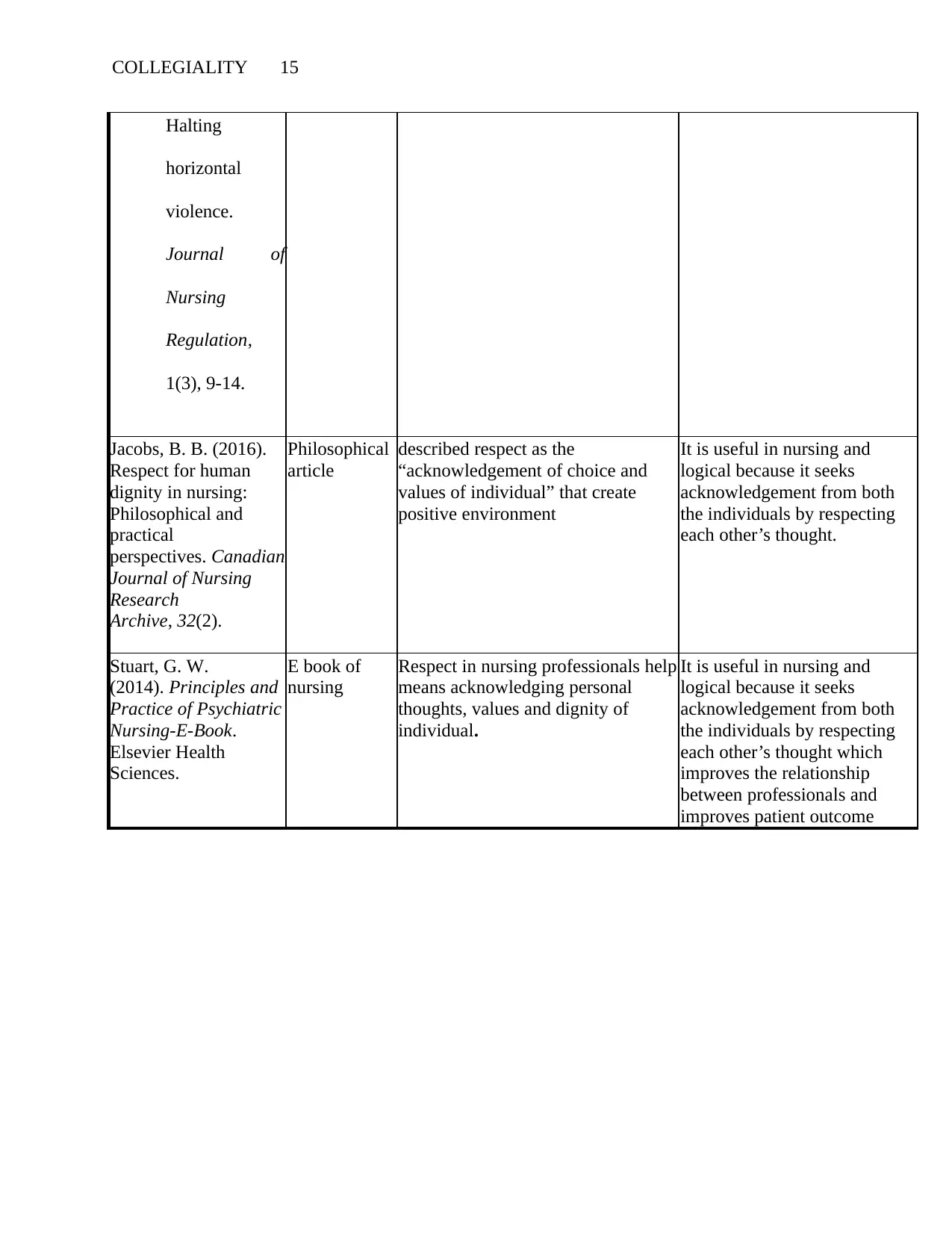
COLLEGIALITY 15
Halting
horizontal
violence.
Journal of
Nursing
Regulation,
1(3), 9-14.
Jacobs, B. B. (2016).
Respect for human
dignity in nursing:
Philosophical and
practical
perspectives. Canadian
Journal of Nursing
Research
Archive, 32(2).
Philosophical
article
described respect as the
“acknowledgement of choice and
values of individual” that create
positive environment
It is useful in nursing and
logical because it seeks
acknowledgement from both
the individuals by respecting
each other’s thought.
Stuart, G. W.
(2014). Principles and
Practice of Psychiatric
Nursing-E-Book.
Elsevier Health
Sciences.
E book of
nursing
Respect in nursing professionals help
means acknowledging personal
thoughts, values and dignity of
individual.
It is useful in nursing and
logical because it seeks
acknowledgement from both
the individuals by respecting
each other’s thought which
improves the relationship
between professionals and
improves patient outcome
Halting
horizontal
violence.
Journal of
Nursing
Regulation,
1(3), 9-14.
Jacobs, B. B. (2016).
Respect for human
dignity in nursing:
Philosophical and
practical
perspectives. Canadian
Journal of Nursing
Research
Archive, 32(2).
Philosophical
article
described respect as the
“acknowledgement of choice and
values of individual” that create
positive environment
It is useful in nursing and
logical because it seeks
acknowledgement from both
the individuals by respecting
each other’s thought.
Stuart, G. W.
(2014). Principles and
Practice of Psychiatric
Nursing-E-Book.
Elsevier Health
Sciences.
E book of
nursing
Respect in nursing professionals help
means acknowledging personal
thoughts, values and dignity of
individual.
It is useful in nursing and
logical because it seeks
acknowledgement from both
the individuals by respecting
each other’s thought which
improves the relationship
between professionals and
improves patient outcome
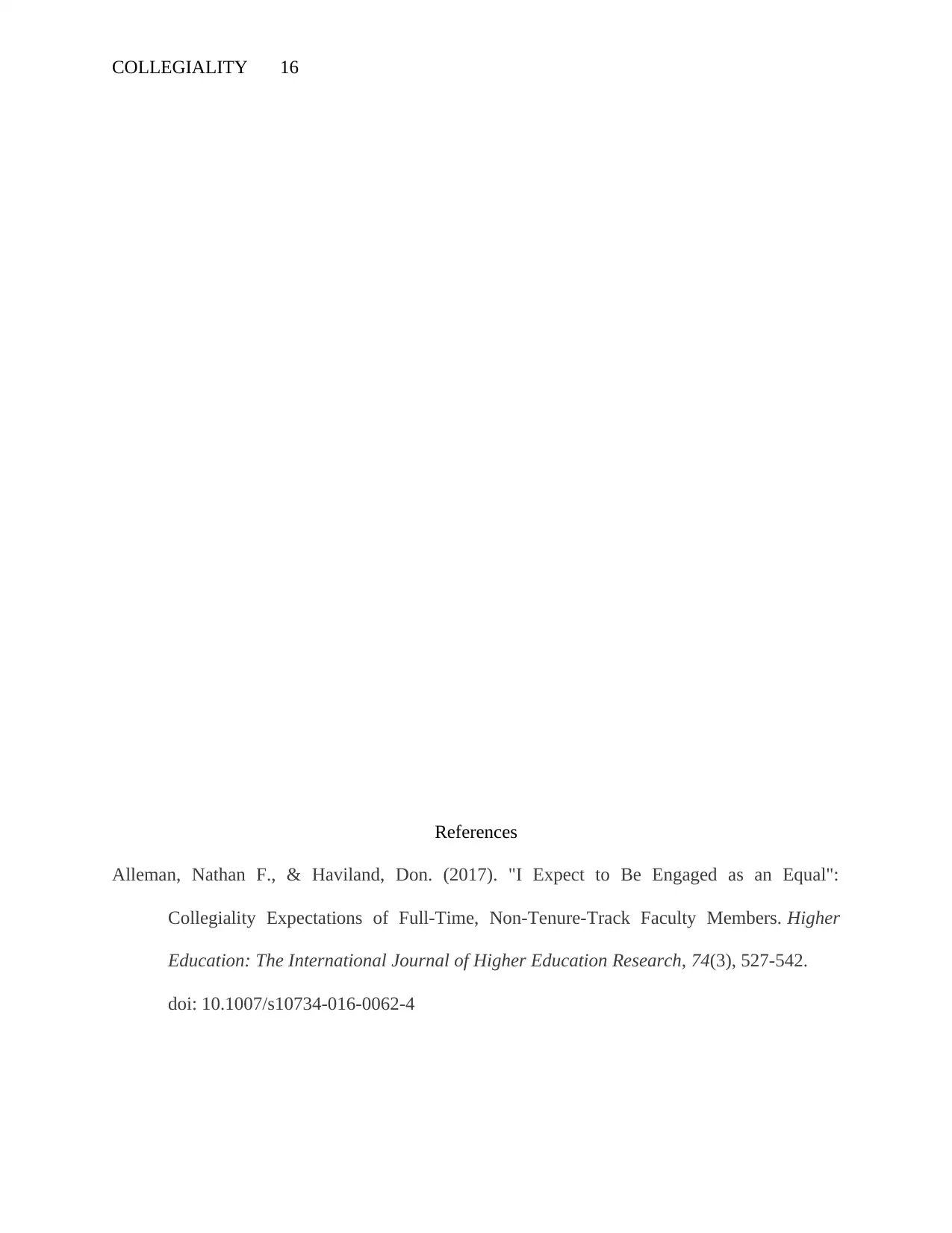
COLLEGIALITY 16
References
Alleman, Nathan F., & Haviland, Don. (2017). "I Expect to Be Engaged as an Equal":
Collegiality Expectations of Full-Time, Non-Tenure-Track Faculty Members. Higher
Education: The International Journal of Higher Education Research, 74(3), 527-542.
doi: 10.1007/s10734-016-0062-4
References
Alleman, Nathan F., & Haviland, Don. (2017). "I Expect to Be Engaged as an Equal":
Collegiality Expectations of Full-Time, Non-Tenure-Track Faculty Members. Higher
Education: The International Journal of Higher Education Research, 74(3), 527-542.
doi: 10.1007/s10734-016-0062-4
Secure Best Marks with AI Grader
Need help grading? Try our AI Grader for instant feedback on your assignments.
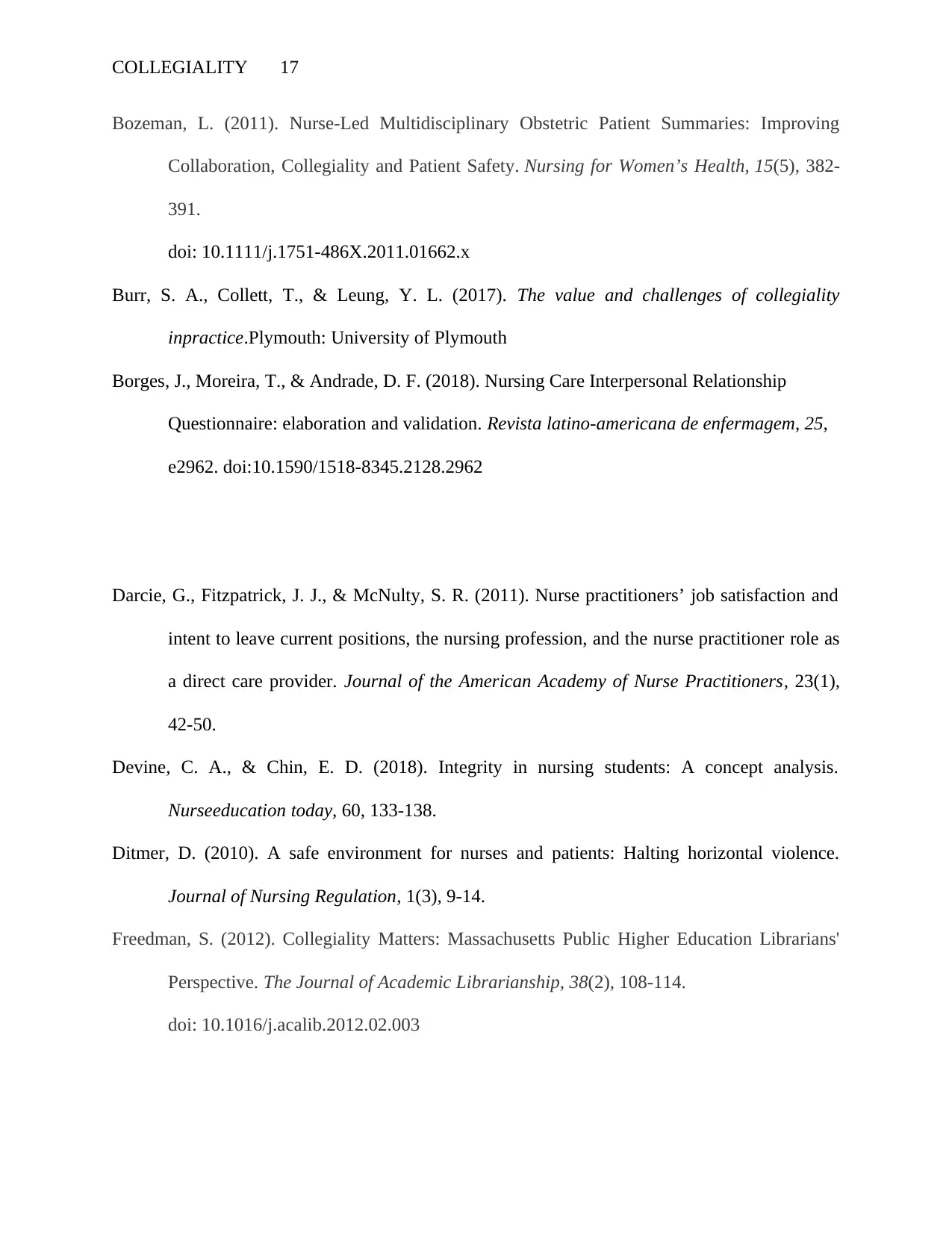
COLLEGIALITY 17
Bozeman, L. (2011). Nurse-Led Multidisciplinary Obstetric Patient Summaries: Improving
Collaboration, Collegiality and Patient Safety. Nursing for Women’s Health, 15(5), 382-
391.
doi: 10.1111/j.1751-486X.2011.01662.x
Burr, S. A., Collett, T., & Leung, Y. L. (2017). The value and challenges of collegiality
inpractice.Plymouth: University of Plymouth
Borges, J., Moreira, T., & Andrade, D. F. (2018). Nursing Care Interpersonal Relationship
Questionnaire: elaboration and validation. Revista latino-americana de enfermagem, 25,
e2962. doi:10.1590/1518-8345.2128.2962
Darcie, G., Fitzpatrick, J. J., & McNulty, S. R. (2011). Nurse practitioners’ job satisfaction and
intent to leave current positions, the nursing profession, and the nurse practitioner role as
a direct care provider. Journal of the American Academy of Nurse Practitioners, 23(1),
42-50.
Devine, C. A., & Chin, E. D. (2018). Integrity in nursing students: A concept analysis.
Nurseeducation today, 60, 133-138.
Ditmer, D. (2010). A safe environment for nurses and patients: Halting horizontal violence.
Journal of Nursing Regulation, 1(3), 9-14.
Freedman, S. (2012). Collegiality Matters: Massachusetts Public Higher Education Librarians'
Perspective. The Journal of Academic Librarianship, 38(2), 108-114.
doi: 10.1016/j.acalib.2012.02.003
Bozeman, L. (2011). Nurse-Led Multidisciplinary Obstetric Patient Summaries: Improving
Collaboration, Collegiality and Patient Safety. Nursing for Women’s Health, 15(5), 382-
391.
doi: 10.1111/j.1751-486X.2011.01662.x
Burr, S. A., Collett, T., & Leung, Y. L. (2017). The value and challenges of collegiality
inpractice.Plymouth: University of Plymouth
Borges, J., Moreira, T., & Andrade, D. F. (2018). Nursing Care Interpersonal Relationship
Questionnaire: elaboration and validation. Revista latino-americana de enfermagem, 25,
e2962. doi:10.1590/1518-8345.2128.2962
Darcie, G., Fitzpatrick, J. J., & McNulty, S. R. (2011). Nurse practitioners’ job satisfaction and
intent to leave current positions, the nursing profession, and the nurse practitioner role as
a direct care provider. Journal of the American Academy of Nurse Practitioners, 23(1),
42-50.
Devine, C. A., & Chin, E. D. (2018). Integrity in nursing students: A concept analysis.
Nurseeducation today, 60, 133-138.
Ditmer, D. (2010). A safe environment for nurses and patients: Halting horizontal violence.
Journal of Nursing Regulation, 1(3), 9-14.
Freedman, S. (2012). Collegiality Matters: Massachusetts Public Higher Education Librarians'
Perspective. The Journal of Academic Librarianship, 38(2), 108-114.
doi: 10.1016/j.acalib.2012.02.003
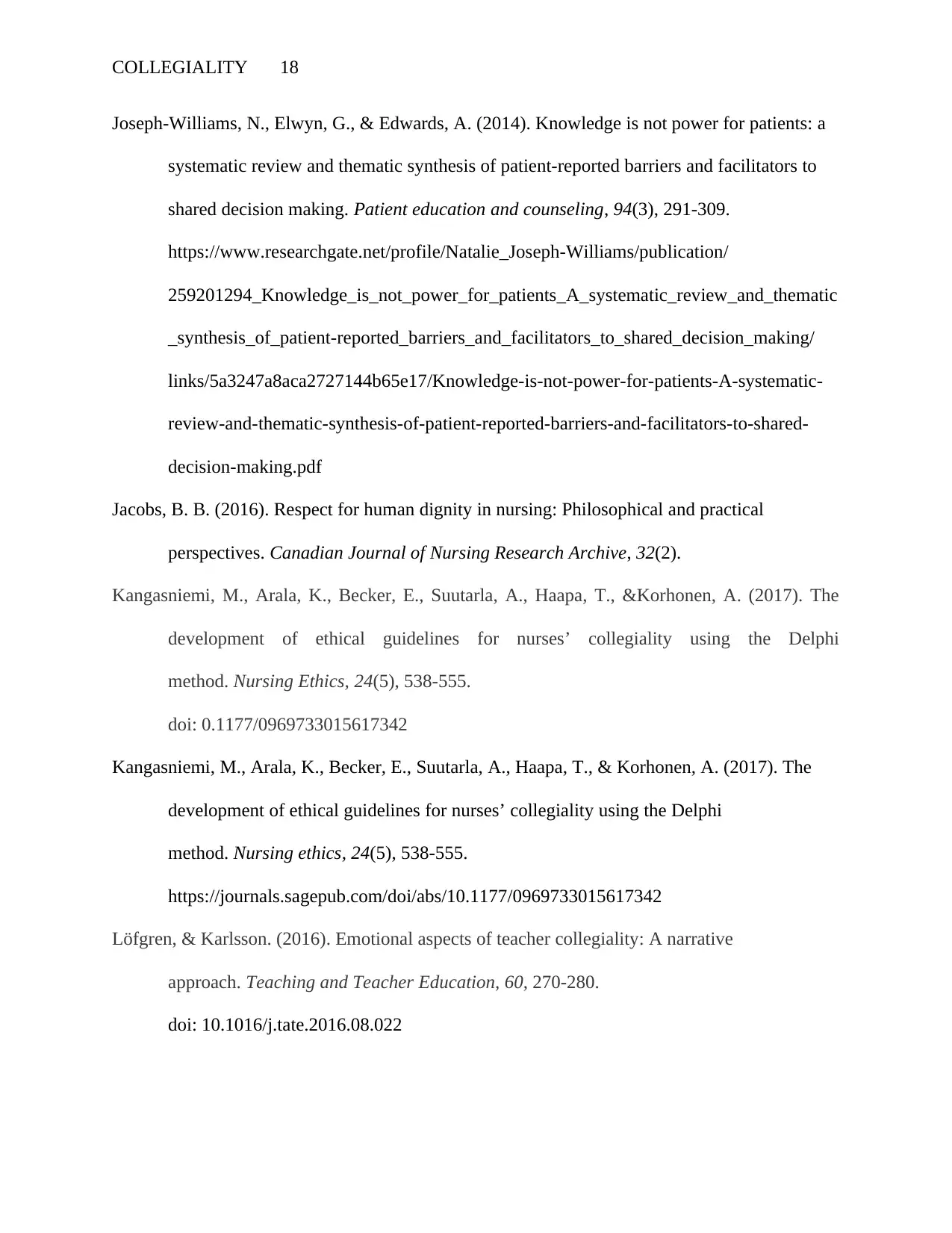
COLLEGIALITY 18
Joseph-Williams, N., Elwyn, G., & Edwards, A. (2014). Knowledge is not power for patients: a
systematic review and thematic synthesis of patient-reported barriers and facilitators to
shared decision making. Patient education and counseling, 94(3), 291-309.
https://www.researchgate.net/profile/Natalie_Joseph-Williams/publication/
259201294_Knowledge_is_not_power_for_patients_A_systematic_review_and_thematic
_synthesis_of_patient-reported_barriers_and_facilitators_to_shared_decision_making/
links/5a3247a8aca2727144b65e17/Knowledge-is-not-power-for-patients-A-systematic-
review-and-thematic-synthesis-of-patient-reported-barriers-and-facilitators-to-shared-
decision-making.pdf
Jacobs, B. B. (2016). Respect for human dignity in nursing: Philosophical and practical
perspectives. Canadian Journal of Nursing Research Archive, 32(2).
Kangasniemi, M., Arala, K., Becker, E., Suutarla, A., Haapa, T., &Korhonen, A. (2017). The
development of ethical guidelines for nurses’ collegiality using the Delphi
method. Nursing Ethics, 24(5), 538-555.
doi: 0.1177/0969733015617342
Kangasniemi, M., Arala, K., Becker, E., Suutarla, A., Haapa, T., & Korhonen, A. (2017). The
development of ethical guidelines for nurses’ collegiality using the Delphi
method. Nursing ethics, 24(5), 538-555.
https://journals.sagepub.com/doi/abs/10.1177/0969733015617342
Löfgren, & Karlsson. (2016). Emotional aspects of teacher collegiality: A narrative
approach. Teaching and Teacher Education, 60, 270-280.
doi: 10.1016/j.tate.2016.08.022
Joseph-Williams, N., Elwyn, G., & Edwards, A. (2014). Knowledge is not power for patients: a
systematic review and thematic synthesis of patient-reported barriers and facilitators to
shared decision making. Patient education and counseling, 94(3), 291-309.
https://www.researchgate.net/profile/Natalie_Joseph-Williams/publication/
259201294_Knowledge_is_not_power_for_patients_A_systematic_review_and_thematic
_synthesis_of_patient-reported_barriers_and_facilitators_to_shared_decision_making/
links/5a3247a8aca2727144b65e17/Knowledge-is-not-power-for-patients-A-systematic-
review-and-thematic-synthesis-of-patient-reported-barriers-and-facilitators-to-shared-
decision-making.pdf
Jacobs, B. B. (2016). Respect for human dignity in nursing: Philosophical and practical
perspectives. Canadian Journal of Nursing Research Archive, 32(2).
Kangasniemi, M., Arala, K., Becker, E., Suutarla, A., Haapa, T., &Korhonen, A. (2017). The
development of ethical guidelines for nurses’ collegiality using the Delphi
method. Nursing Ethics, 24(5), 538-555.
doi: 0.1177/0969733015617342
Kangasniemi, M., Arala, K., Becker, E., Suutarla, A., Haapa, T., & Korhonen, A. (2017). The
development of ethical guidelines for nurses’ collegiality using the Delphi
method. Nursing ethics, 24(5), 538-555.
https://journals.sagepub.com/doi/abs/10.1177/0969733015617342
Löfgren, & Karlsson. (2016). Emotional aspects of teacher collegiality: A narrative
approach. Teaching and Teacher Education, 60, 270-280.
doi: 10.1016/j.tate.2016.08.022
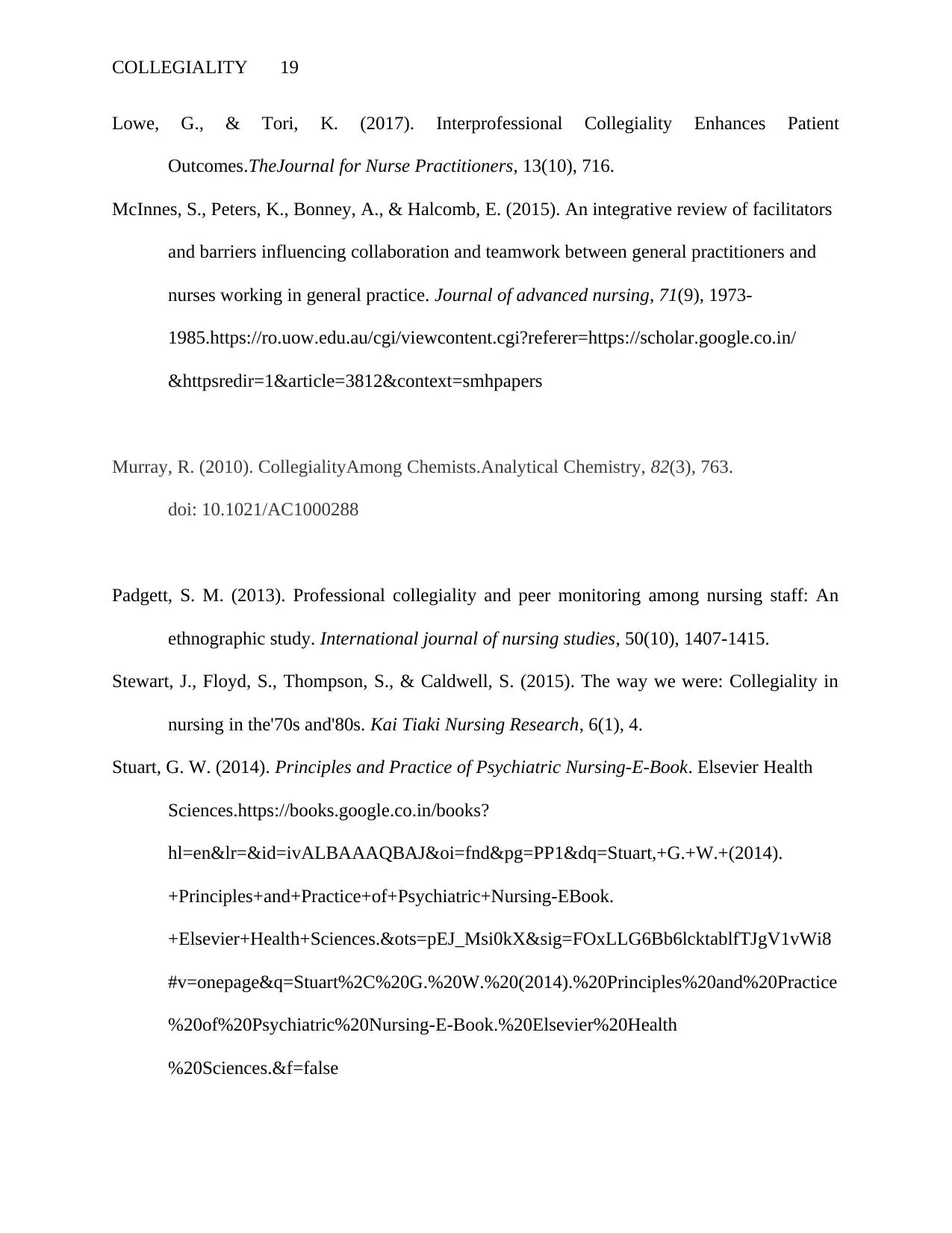
COLLEGIALITY 19
Lowe, G., & Tori, K. (2017). Interprofessional Collegiality Enhances Patient
Outcomes.TheJournal for Nurse Practitioners, 13(10), 716.
McInnes, S., Peters, K., Bonney, A., & Halcomb, E. (2015). An integrative review of facilitators
and barriers influencing collaboration and teamwork between general practitioners and
nurses working in general practice. Journal of advanced nursing, 71(9), 1973-
1985.https://ro.uow.edu.au/cgi/viewcontent.cgi?referer=https://scholar.google.co.in/
&httpsredir=1&article=3812&context=smhpapers
Murray, R. (2010). CollegialityAmong Chemists.Analytical Chemistry, 82(3), 763.
doi: 10.1021/AC1000288
Padgett, S. M. (2013). Professional collegiality and peer monitoring among nursing staff: An
ethnographic study. International journal of nursing studies, 50(10), 1407-1415.
Stewart, J., Floyd, S., Thompson, S., & Caldwell, S. (2015). The way we were: Collegiality in
nursing in the'70s and'80s. Kai Tiaki Nursing Research, 6(1), 4.
Stuart, G. W. (2014). Principles and Practice of Psychiatric Nursing-E-Book. Elsevier Health
Sciences.https://books.google.co.in/books?
hl=en&lr=&id=ivALBAAAQBAJ&oi=fnd&pg=PP1&dq=Stuart,+G.+W.+(2014).
+Principles+and+Practice+of+Psychiatric+Nursing-EBook.
+Elsevier+Health+Sciences.&ots=pEJ_Msi0kX&sig=FOxLLG6Bb6lcktablfTJgV1vWi8
#v=onepage&q=Stuart%2C%20G.%20W.%20(2014).%20Principles%20and%20Practice
%20of%20Psychiatric%20Nursing-E-Book.%20Elsevier%20Health
%20Sciences.&f=false
Lowe, G., & Tori, K. (2017). Interprofessional Collegiality Enhances Patient
Outcomes.TheJournal for Nurse Practitioners, 13(10), 716.
McInnes, S., Peters, K., Bonney, A., & Halcomb, E. (2015). An integrative review of facilitators
and barriers influencing collaboration and teamwork between general practitioners and
nurses working in general practice. Journal of advanced nursing, 71(9), 1973-
1985.https://ro.uow.edu.au/cgi/viewcontent.cgi?referer=https://scholar.google.co.in/
&httpsredir=1&article=3812&context=smhpapers
Murray, R. (2010). CollegialityAmong Chemists.Analytical Chemistry, 82(3), 763.
doi: 10.1021/AC1000288
Padgett, S. M. (2013). Professional collegiality and peer monitoring among nursing staff: An
ethnographic study. International journal of nursing studies, 50(10), 1407-1415.
Stewart, J., Floyd, S., Thompson, S., & Caldwell, S. (2015). The way we were: Collegiality in
nursing in the'70s and'80s. Kai Tiaki Nursing Research, 6(1), 4.
Stuart, G. W. (2014). Principles and Practice of Psychiatric Nursing-E-Book. Elsevier Health
Sciences.https://books.google.co.in/books?
hl=en&lr=&id=ivALBAAAQBAJ&oi=fnd&pg=PP1&dq=Stuart,+G.+W.+(2014).
+Principles+and+Practice+of+Psychiatric+Nursing-EBook.
+Elsevier+Health+Sciences.&ots=pEJ_Msi0kX&sig=FOxLLG6Bb6lcktablfTJgV1vWi8
#v=onepage&q=Stuart%2C%20G.%20W.%20(2014).%20Principles%20and%20Practice
%20of%20Psychiatric%20Nursing-E-Book.%20Elsevier%20Health
%20Sciences.&f=false
Paraphrase This Document
Need a fresh take? Get an instant paraphrase of this document with our AI Paraphraser

COLLEGIALITY 20
Thompson, E. M. (2010). Team collegiality is key to patient safety. OR Nurse, 4(4), 5.
doi: 10.1097/01.ORN.0000384184.81009.21
Twigg, D., & McCullough, K. (2014). Nurse retention: A review of strategies to create and
enhance positive practice environments in clinical settings. International journal
ofnursing studies, 51(1), 85-92.
Vagharseyyedin, S. A. (2016). An integrative review of literature on determinants of nurses’
organizational commitment. Iranian journal of nursing and midwifery research, 21(2),
107. https://www.ncbi.nlm.nih.gov/pmc/articles/PMC4815364/
Walker, L. O., & Avant, K. C. (2005). Strategies for theory construction in nursing(4th ed.).
Upper Saddle River, NJ.: Pearson/Prentice Hall.
Yang, C. I., & Chao, S. Y. (2018). Clinical nursing instructors' perceived challenges in clinical
teaching. Japan Journal of Nursing Science, 15(1), 50-55.
Thompson, E. M. (2010). Team collegiality is key to patient safety. OR Nurse, 4(4), 5.
doi: 10.1097/01.ORN.0000384184.81009.21
Twigg, D., & McCullough, K. (2014). Nurse retention: A review of strategies to create and
enhance positive practice environments in clinical settings. International journal
ofnursing studies, 51(1), 85-92.
Vagharseyyedin, S. A. (2016). An integrative review of literature on determinants of nurses’
organizational commitment. Iranian journal of nursing and midwifery research, 21(2),
107. https://www.ncbi.nlm.nih.gov/pmc/articles/PMC4815364/
Walker, L. O., & Avant, K. C. (2005). Strategies for theory construction in nursing(4th ed.).
Upper Saddle River, NJ.: Pearson/Prentice Hall.
Yang, C. I., & Chao, S. Y. (2018). Clinical nursing instructors' perceived challenges in clinical
teaching. Japan Journal of Nursing Science, 15(1), 50-55.
1 out of 20
Related Documents
Your All-in-One AI-Powered Toolkit for Academic Success.
+13062052269
info@desklib.com
Available 24*7 on WhatsApp / Email
![[object Object]](/_next/static/media/star-bottom.7253800d.svg)
Unlock your academic potential
© 2024 | Zucol Services PVT LTD | All rights reserved.





